




















































































































THE shortlist of finalists for the UK Aquaculture Awards 2023 has been announced. The contenders include leading fish farmers, suppliers and not-for-profit organisations, as well as rising stars in the industry.
The final awards results will be announced at a gala dinner in Inverness on 15 June.
RISING STAR
Alison Brough, Scottish Sea Farms, United Kingdom
Eleanor Lawrie, Mowi, United Kingdom
Ben Leigh, Kames Fish Farming Ltd, United Kingdom
COLLABORATION
Salmon Scotland in collaboration with SAMS

Enterprise, Rowett Aberdeen University, Scottish Sea Farms, Stirling Council and SAIC
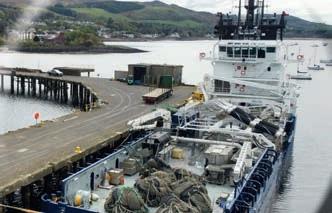

Regal Springs, Switzerland with Ace
Aquatec, Nautilus Collaboration and The Centre for Responsible Seafood (TCRS)
Rare Earth Global in collaboration with the Institute of Aquaculture
(IoA), United Kingdom
INNOVATION
Bluegreen Fusion AS, the world’s largest thermoplastic structure, Norway
DSM Nutritional Products, Digital SalmoFan™, Switzerland
Aqua Clean Tas Pty Ltd, Tassie Devil Tracker 4000, Australia

SUSTAINABILITY
Selcoth Fisheries Ltd, United Kingdom

Mowi, United Kingdom
W&J Knox Ltd, United Kingdom
COMMUNITY INITIATIVE
Mowi, United Kingdom
Organic Sea Harvest & Cargill – From the Sea to the Land Community Initiative, United Kingdom
Kames Fish Farming Ltd, United Kingdom
FARMER OF THE YEAR
Paul Luckhoff, Kames Fish Farming Ltd, United Kingdom
James Ronald, Bakkafrost Scotland
Cameron Jones, Mowi, United Kingdom
Dr Farshad Shishehchian, Blue


Aqua International Pte Ltd, Singapore
ANIMAL WELFARE
Kames Fish Farming Ltd, United Kingdom
World Feeds Ltd, United Kingdom
Bakkafrost Scotland, United Kingdom
AQUACULTURE SUPPLIER OF THE YEAR
Underwater Contracting Ltd (UCO), United Kingdom
Tom Morrow Tarpaulins (Inverness)
Ltd, United Kingdom
Ocean On Land Technology Ltd, United Kingdom
BEST NEW STARTUP
Aqualicense, Ireland
ThinkAqua, United Kingdom
Wellfish Diagnostics Ltd, United Kingdom
UNSUNG HERO
Stephen Hendry, ScaleAQ
Eoghan MacInnes, Kames Fish Farming Ltd, United Kingdom


Dr Lesley McEvoy, UHI Shetland, United Kingdom
Charlie Bain, Underwater Contracting Ltd (UCO), United Kingdom
Alex Adrian, Crown Estate Scotland, United Kingdom
Roger Halsebakk from Solvtrans, Norway Ronnie Soutar, Scottish Sea Farms, United Kingdom
Awards for the Best Aquaculture Company and the Judges’ Special Recognition Award will also be announced on the night.
To book a place at the Awards or for further information, go online to aquacultureawards.com
lice, farm escapes and transferrable diseases… few effective measures have been translated into practical action to manage the adverse effects of... farms on wild Atlantic salmon stocks.”
A panel of external experts set up to review the work of an intergovernmental salmon conservation body says more needs to be done to protect wild salmon, including tighter restrictions on aquaculture.
The North Atlantic Salmon Conservation Organisation (NASCO) was set up in the 1980s and the latest review – Report of the Third NASCO Performance Review – is its third.The external panel was made up of Jean-Jacques Maguire (Fisheries Science); Philip McGinnity (Salmon Management and Conservation); and Erik J Molenaar (Marine/Fisheries Law).
The panel’s report finds that regulation of marine fisheries has been largely successful, although bycatch of salmon at sea remains a problem.
The report identifies two key problem areas, however: river habitat conservation and the impact of fish farming. On these, the panel says: “Implementation of the protection and restoration of habitats and for the management of aquaculture interactions has been less successful.There appears to be poor engagement by the relevant jurisdictions in this area resulting in lack of action and very limited progress.”
On aquaculture specifically, the report says: “The salmon aquaculture industry has experienced enormous growth in the North Atlantic with substantial increases in the quantity of sea
The panel call for a “zero escapes” and “zero sea lice-related mortalities” policy. It is also dismissive of NASCO’s plan to commission a report on farmed and wild salmon interactions on the grounds that “there is more than enough information upon which to proceed operationally”.
Rachel Mulrenan, Scotland Director of campaigning organisation WildFish, said: “This new report lays bare the blatant hypocrisy of the Scottish government.The reality is that it has systematically ignored the implementation of NASCO’s resolutions, guidelines and agreements over many years, while kicking salmon farming regulation ever further down the road.”
A Scottish government spokesperson said: “The Scottish government takes the issue of our declining salmon stocks very seriously and is committed to working with our partners, both domestic and international, to safeguard this iconic species.
“We value the role of aquaculture in producing worldrenowned healthy and quality seafood... however, we recognise that its delivery and development must be sustainable and with appropriate regulatory frameworks while maintaining high environmental standards.
“We remain committed to ensuring the regulation of the interactions of sea lice and SEPA [the Scottish Environment Protection Agency] is preparing for a further phase of consultation on a sea lice risk assessment framework this spring. We are also exploring how to strengthen the escapes regulatory regime, including the introduction of penalties.”
A Dorset fish farm that is home to the UK's only genetically selected strain of rainbow trout is being put up for sale.


Houghton Springs, a fish farm with its own recirculating aquaculture system (RAS) hatchery, is the UK’s only producer of Arctic charr and has also developed its own strain of rainbow trout, the “Winterborne”. The fish are reared as stock for sport and for the table, with high-end restaurants among the customers.
Hans Hoff, who has been the farm’s proprietor since 1986, is retiring from the business and aims to sell the farm, hatchery and associated farm equipment, (including a MASKON digital egg sorting unit), as a going concern. There are two employees currently working at the farm in addition to Hoff.
Houghton Springs Fish Farm is situated in North Dorset downland and draws on the aquifer supplying the River Winterborne at Winterborne Houghton.

Originally established as a mixed farm for restocking of both rainbows and brown trout, it is at present geared to facilitate genetic selection of the Winterborne enhanced-growth rainbow strain in tandem with the only Arctic charr production in England, ultimately

destined for either the table or the sporting market. In 2006, the first Arctic Charr ova were imported from Canada with the view to diversify the business.
The Winterborne strain of trout is aimed at achieving faster growth and more efficient feed conversion, reducing the farm’s impact on wild fish as a feed ingredient. By using genetic selection rather than traditional broodstock selection, Houghton Springs has been able to reduce inbreeding. Through its breeding protocol, in collaboration with Noahgene, over the
last 17 years, the farm has also removed some “domesticated” traits and brought the fish back in line with its wild ancestors. The Winterborne trout also have twice the average of beneficial Omega 3 fatty acids contend in the fillet, according to Stirling University’s findings.
Houghton Springs’ sustainability credentials include the adherence to The GLOBALGAP Aquaculture Standard.
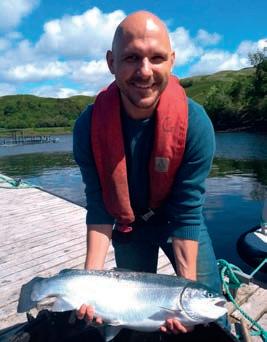
Loch Duart has promoted Hazel Wade to the post of Operations Director. Wade has worked with


Loch Duart for more than 18 years and has been Operations Manager since 2019. She brings 20-plus years of experience in the aquaculture sector to the role at a pivotal time when the company is expanding operations. Wade said: “It’s rare to have a job where you get to see the results of your work grow in front of you, from tiny eggs into fit, healthy adult salmon. I’m thrilled to take on this role and to work with our dedicated farm teams to care for our salmon in this beautiful environment.

THE Mowi Scotland fish farm sites at Marulaig Bay, on South Uist, and the Isle of Scalpay, both in the Outer Hebrides, have been certified by the Aquaculture Stewardship Council (ASC), one of the leading international aquaculture standard-setting bodies. Marulaig Bay has also received certification for its organic salmon.
JOSIP Barišić, R&D Manager with WellFish, is the new President of the Fish Veterinary Society (FVS). He took up the post, succeeding Aqua Pharma’s Rachel Brown, at the FVS Annual Spring Conference in Edinburgh in March.
Brown is now Senior VicePresident and the new Junior VicePresident is Máirín-Rua Ní Aodha of University College Dublin.
The FVS is a specialist division of the British Veterinary Association.
A project on the island of Arran to build and test two prototype electric workboats has secured up to £163,130 investment from Highlands and Islands Enterprise (HIE).
Arran Workboats Limited (AWL) supplies petrol- and dieselpowered workboats to many operators of Scotland’s 200 or so fish farms and to companies in other marine industries such as renewables, diving, port authorities, universities and tourism.
The company now wants to develop electric versions of its two workboat models in a move that could help the country’s transition to net-zero emissions.There is already interest in the idea from companies in several marine sectors.
A key challenge, the company said, is meeting the stringent safety standards set by the Maritime and Coastguard Agency, particularly addressing concerns about fire risk.
AWL is to design and build two prototype electric versions of its twin-propulsion workboats, one for each of the boat lengths it currently produces.The prototypes will be used for test and demonstration purposes and to assess the potential for commercial production.
Calum Monteith, Director at Arran Workboats Ltd, said: “We firmly believe our electric propulsion proposition is the future, and will help the fish farm companies and other industries reduce their emissions from fossil fuels and help deliver their net-zero aspirations."
The company said it was determined to use Scotland-based supply chain companies as much as possible, and AWL is already working with another local company on energy requirement calculations.
Morag Goodfellow, HIE’s Area Manager for Argyll and the Islands, commented: “This project by Arran Workboats could help to reduce the carbon impacts, not only of the company itself, but of wider marine industries. Successful certification of electric workboats will open up new opportunities for the company as [its] customers take their own steps towards net zero.
“At the same time, it will sustain vital manufacturing jobs on Arran, where most other employment is tourism based. All of this contributes to wider community and population resilience.”
Monteith added: “We have been researching the electric propulsion market for a couple of years and believe we can deliver a product that would suit our customers’ needs, and we have been encouraged greatly by the response from our customer base.”
OUR article "Keen to be Green" (Fish Farmer, March 2023) incorrectly described the vessel Geraldine Mary, on long-term contract to Scottish Sea Farms from Inverlussa Marine Services, as having been designed and delivered by Macduff Shipyards. In fact, the vessel was designed by Macduff Ship Design and built by Macduff Shipyards, which are separate companies. Geraldine Mary is a sister vessel to the Helen Rice built by Ferguson Marine a few years previously.
SCOTLAND’S Rural Affairs Secretary, Mairi Gougeon, has retained her post following the cabinet reshuffle by newly elected First Minister Humza Yousaf. Her role has been renamed “Cabinet Secretary for Rural Affairs, Land Reform and Islands”.

On 27 March it was announced that Yousaf had been elected as leader of the Scottish National Party, beating his nearest rival Kate Forbes by 52% to 48% once second preferences had been counted. He was confirmed by the Scottish Parliament as First Minister the following day.
It also emerged that Kate Forbes, who is on maternity leave from her role as Finance Secretary, had turned down the offer of a move to the Rural Affairs portfolio, saying she preferred to support the new leader from the back benches.The proposed move to Rural Affairs was widely seen as a demotion from the finance brief, although, as an MSP representing Skye and Lochaber, it might have been seen as an area of special interest for her.
It is not clear whether another post had been lined up for Gougeon, but since her appointment as Rural Affairs Secretary in May 2021 she has been well liked, and is regarded as having struck a fair balance between the demands of the rural and island economies and environmental considerations.
As far as aquaculture is concerned, among the challenges coming up this year are the finalisation of the Scottish government’s Vision for Aquaculture (which was due to be published at the end of last year) and negotiating the impact on fish farming and catch fishing of the proposed legislation on Highly Protected Marine Areas (HPMAs), which has proved unpopular among some coastal communities.
Tavish Scott, Chief Executive of Salmon Scotland, said: “We have enjoyed an excellent relationship with Mairi and we look forward to continuing our positive engagement.
“She fully understands the vital importance of our sector, which contributes £760m to the economy, and knows how hard our farmers work to prioritise fish welfare and produce one of the most nutritious products we can eat.
“We have a number of issues we want the Scottish government to prioritise, including the rural housing shortage and the need for a more streamlined licensing regime, so that we can deliver further sustainable growth in Scotland.”
Meanwhile, Mairi McAllan, who was previously Minister for Environment, Biodiversity and Land Reform, has been promoted to the new role of Cabinet Secretary for Net Zero and Just Transition. Land reform is now part of Mairi Gougeon's brief and biodiversity has been picked up by the Green Party's Lorna Slater, who is now Minister for Green Skills, Circular Economy and Biodiversity.
► Powerful waterbased antifouling that offers excellent protection against fouling
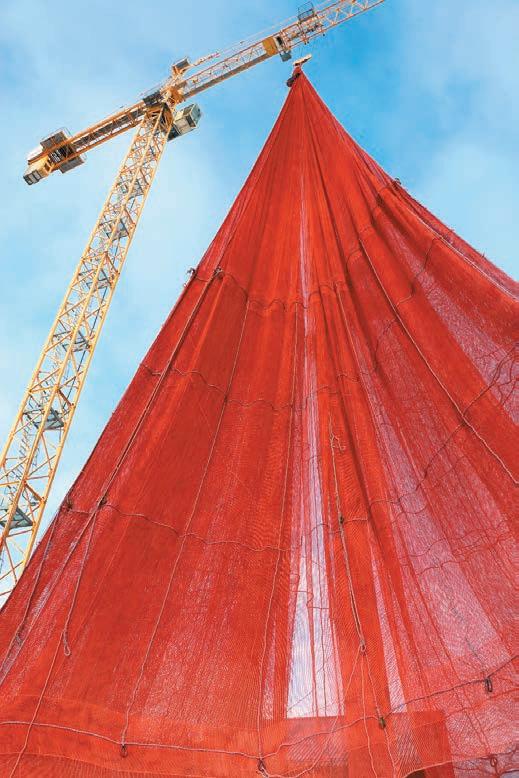
► Safe for the fish and for the environment
► Protects against UV radiation
► Controlled leaking of the active ingredient
► Contains no microplastics
► Based on 35 years of experience
THE line-up for the Blue Food Innovation Summit, which takes place in London on 23–24 May, now includes more than 90 leading speakers.
The summit will get underway with a keynote address from Jim Leape, Co-Director at the Center For Ocean Solutions at Stanford University, on “Raising the Profile of Blue Food in Climate, Sustainability and Food Conversations”.



Other speakers include Nathan PyneCarter, CEO with marine technology business Ace Aquatec; Jennifer Bushman, CMO at salmon producer Kvarøy Arctic; Amy Novogratz, Managing Director at investor AquaSpark; and Ohad Maiman, Founder and


former CEO, The Kingfish Company. The summit will feature panels and pitches discussing a range of blue economy topics including sustainable aquafeed, seaweed, fish health and welfare, and digital platforms for small farmers. By showcasing disruptive technologies, and exploring case studies of innovation in action, the focus is on overcoming bottlenecks to growth and promoting greater partnership and collaboration to
protect and restore the ocean ecosystem.
From producers, feed suppliers and health providers to retailers, investors and innovators, the summit provides stakeholders from across the value chain with a vital platform for knowledge exchange and networking through interactive panels, breakout discussions, and quality one-toone meetings.
Blue Food Innovation Summit, London, 23-24 May.To book or for more details, go online to www.bluefoodinnovation.com


INDUSTRY body Salmon Scotland has called for a rethink on proposals to ban industry in 10% of Scotland’s coastal waters.
Tavish Scott, the organisation's Chief Executive, wrote last month to all three of the candidates in the running for leadership of the SNP: Humza Yousaf, Kate Forbes and Ash Regan.




The Scottish government plans to introduce Highly Protected Marine Areas (HPMAs), a new category of marine protection that would exclude most forms of commercial activity, including fish farms.
Scott wrote in his letter: “We ask that government




thoroughly consider the social and economic impacts of this policy on the sectors, industries and communities that operate in Scotland’s coastal regions, as well as those that are impacted across Scotland, through the supply chain.
“That is yet to happen and if government does proceed with this policy, a thorough understanding of the impact on business, livelihoods and communities is essential.”
He stressed the economic importance of the salmon industry, the UK’s biggest single food export.
Scott also renewed a call for faster progress on implementing Professor Russel Griggs’
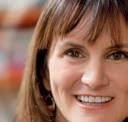
SEAFOOD Scotland has said the trade show Seafood North America, held in Boston, Massachusetts, last month presented an “unmissable opportunity” to promote Scottish produce to North American consumers.
Seafood North America (SENA), which took place on 12–14 March, is one of the world’s leading trade shows for the sector and the biggest in its region.
Seafood Scotland hosted 10 Scottish companies on its Scottish pavilion, with a further eight attending the event, all there to meet buyers face to face and capitalise on the commercial opportunities in the North American market.

Adam Wing, Head of Trade Marketing for UK, Americas & New Markets, said: “SENA gives us an unmissable opportunity
recommendations on reforming the aquaculture consenting process.
The commitment to introduce HPMAs was part of the SNP’s Bute House agreement with the Scottish Greens, which secured the SNP’s position in Holyrood.
Forbes, who finished second in the leadership election, had called for the HPMA proposals to be shelved. Instead Forbes, who represents Skye, Lochaber and Badenoch, would prefer to see a feasibility study into devolving marine protection to local authorities.

Yousaf, who was elected as leader and First Minister, is committed to maintaining the Bute House agreement.
to showcase Scottish seafood to buyers, media and key industry leaders at this renowned event. We know the buyers, and we understand the market and the commercial opportunities."
“With buyers attending from across import, export, hospitality and retail sectors, it allowed us to showcase worldclass seafood from across Scotland. Our industry is passionate about delivering the highest-quality product, the perfect versatile choice for the world’s best chefs or the most discerning customers. SENA helped us reinforce this message and ensure more buyers were aware of the quality produce available from Scotland.”
Seafood Scotland is also due to be represented at Seafood Expo in Barcelona later this month. See page 24 for details.
THE Sustainable Aquaculture Innovation Centre (SAIC) is set to hold a new two-day event focused on the future of aquaculture.
Taking place on 16 and 17 May 2023 at the Technology and Innovation Centre in Glasgow, the Sustainable Aquaculture Summit aims to bring together experts and decision-makers from all areas of seafood production to share knowledge and work together. The programme will cover three core themes: fish health; innovation with impact; and sustainable food, strong communities.

The conference kicks off with a day devoted to the long-term vision for aquaculture, with thought-provoking and challenging discussions featuring experts from the sector, academia and public sector. International guest speakers already confirmed include Emily De Sousa,
a Portuguese-Canadian social media influencer, fisheries scientist and digital strategy consultant; and Tonje Osmundsen, Research Director at the Norwegian University of Science and Technology’s Social Research faculty.
Following an evening of networking and food and drinks at Citation in Glasgow’s Merchant City, the event continues with a packed programme on day two – which is free to attend for all.The second day will focus on the practical delivery of collective aims and ambitions.

Heather Jones, CEO of SAIC, said: “SAIC already acts as a conduit between industry and academia across a range of projects and initiatives, but we’re taking that one step further with our plans to bring together representatives from the entire sector in one room.The flexible nature of the programme and ticketing means that there will be an option for all to attend. Attendance at the first day of the summit (Vision) costs £100 and attendance at the second day (Delivery) is free.The conference dinner (available only to those attending the conference) is £80. For tickets and more information, visit the summit’s Eventbrite page at www.eventbrite. co.uk/e/sustainable-aquaculture-summittickets-538796042467
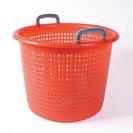

farmer Organic Sea Harvest has appointed James Deverill as the company’s Managing Director. His predecessor as CEO, Ove Thu, will continue in his position as Chairman.
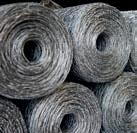
Organic Sea Harvest, based on the Isle of Skye, is the first new independently owned and operated salmon farm in Scotland for decades. Its fish are certified as organic by the Soil Association.


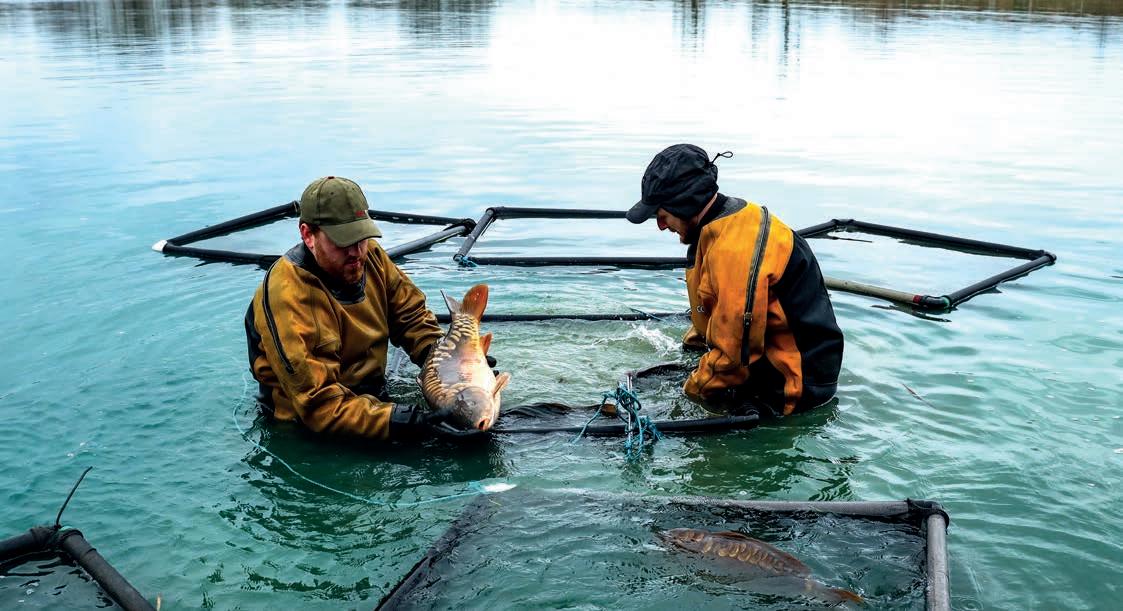
The company operates two farming sites on the north-east coast of Skye and sells its organic salmon under the Isle of Skye Organic Salmon brand.
Deverill was previously Country Director at Cargill Aqua Nutrition (EWOS) in Scotland, where he previously held Commercial Director and Business Development Manager positions.




He has also held roles as Managing Director of Santia Consulting, a leading UK health and safety business, and Director of Research and Innovation at the Sustainable Aquaculture Innovation Centre (SAIC).
Deverill holds a BSc and MSc in aquaculture and a PhD in fish behavioural ecology.
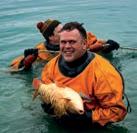





ICELAND IC salmon farmer Ice Fish Farm has raised additional equity capital of €44m ( N OK 500m/£38m) in just a few hours, it was confirmed over the weekend.
The proceeds from the private placement will be used to fund investment and build up biomass.
Four associates had already committed in advance to subscribe around €29m (£25m). The loan agreement is with four banks and is conditional on shareholder loans of €26m being converted into shares.
It has been a busy few weeks for
Ice Fish Farm, whose activities are located on Iceland’s east coast.
A month ago, the company secured a long-term agreement with four banks for a loan of €156.2m (£137m).
A week later, N orway-based Måsøval E iendom, the main shareholder in Ice Fish Farm, announced it had secured a strategic partner through a deal with Icelandic fishing company Ísfélag Vestmannaeyja.

Like Måsøval, Ísfélag Vestmannaeyja is a successful family-owned company with a long, impressive history and deep roots in the Icelandic seafood
sector, and has a lot of similarities with Måsøval E iendom and aligns well with its values.
Ísfélag Vestmannaeyja’s ViceChairman, Einar Sigurðsson said at the time: “We have a long tradition from the fishery sector, but we have over several years followed the strong growth within the salmon farming sector in Iceland.
“We believe that it will be a steadily growing industry in Iceland for many years to come, and create a lot of jobs and value for the communities along the Icelandic coastline.”
NORWAY’S seafood exports were worth NOK 41.4bn (£3.2bn) during the first three months of this year.
This represents an increase of NOK 7.4bn (£573m) or 22%, over the same period last year.
The Norwegian Seafood Council, which compiles the figures, said exports achieved a historically strong quarter in terms of value.
A significantly weaker krone and price growth in the markets for species such as salmon, cod, trout, pollock and herring are the main explanations for the growth.
“This led, among other things, to the export value in March becoming the highest ever in a single month,” said Norwegian Seafood Council CEO Christian Chramer.
He added, however: “There are many value records in the first quarter – for example, for salmon and in the whitefish category – but when we look behind the numbers, it is not as cheerful.
“Strong food inflation and the weak krone explain a good part of the increase in value, and in addition the export
volume of cod and salmon is falling, which helps to raise prices.”
The weak krone alone contributed to lifting the export value by around NOK 3bn (£230m) in the first quarter, while increased prices in the markets contributed NOK 6bn (£465m).
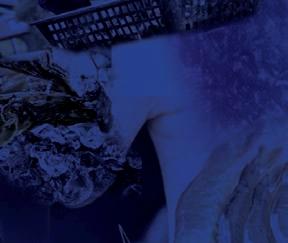

NETFLIX is to feature a new drama about the trials of life on a Norwegian fish farm, the TV media giant has confirmed.




Called Salmon Island, it will feature the rivalry between two families engaged in salmon farming.







The company said that following its global success with Lilyhammer (a Norwegian/American gangster comedy-drama starring Steven van Zandt), creators and writers Anne Bjørnstad and Eilif Skodvin, and production company Rubicon, will return to Netflix with the Salmon Island series.
Bjørnstad and Skodvin said: “In Salmon Island we meet two families in a small coastal community in Norway who are sworn enemies in the global salmon industry.

“The series, which taps into the contemporary zeitgeist, delivers a funny as well as dramatic portrait of the fish farming business.


“Over the last few decades, fish farming has changed both the Norwegian coast and international food culture.






“The time feels right for a television drama about the operators in the industry, and it’s amazing that a global streaming service such as Netflix has the guts to tell such a locally grounded story. We’re pleased to be back with Netflix again after 10 years and we can’t wait to start filming.”
They added that they were delighted that Norway’s Marit Moum Aune was on board as director: “We have collaborated with her on several stage shows and we’re thrilled that she wants to make this series with us.”


Norwegian salmon farming is not without its real-life dramas, of course, as witnessed by the intense battle last year between SalMar founder Gustav Witzøe and Helge Gåsø who created the rival NTS group. Both hail from the same remote island of Frøya.


Witzøe finally won, taking control of NTS, although his rival is now bouncing back with a new fish farming and seafood business.

Overeng previously worked with Mowi in Norway, and also has international experience as Regional Manager for Andromeda (Avramar) in Spain, working with seabass and bream in the Mediterranean, where Garware is a major supplier.

Pål Korneliussen, Garware’s Norwegian Country Manager, said: “We are very pleased to have Olav join the team. As a site manager in Mowi for many years, he has huge operating experience and knows what works in practice. He is well aware of the issues and understands the language of the salmon farmers. For us as a net manufacturer, this is very valuable.”

Former seafood sales executive
Heiða Kristín Helgadóttir has been appointed Managing Director of the Icelandic Marine Cluster, the organisation set up to promote innovation in the country’s aquaculture and fishing sectors.
She takes over this summer. Previously she was with Icelandbased Niceland Seafood as well as being involved in the establishment and operation of software companies in Iceland and the US.

“Glamping” barbecues and endorsement from a celebrity model have helped to raise the profile of Norwegian salmon in South Korea and Thailand.

Mia Sætre Bernhardsen, the Norwegian Seafood Council’s Project Manager in South Korea, and Asbjørn Warvik Rørtveit,
its seafood envoy in Southeast Asia, said that the campaign promoting salmon as part of a luxury outdoor break helped to boost sales in South Korea, while top Thai model and actress Urassaya Sperbund (“Yaya”) had helped spread the message in Thailand.
INVESTMENT group BEWI Invest has bought a large stake in the family-owned salmon farmer SinkabergHansen (SBH) for around NOK 2.2bn (£178m).
The consideration will comprise of a combination of cash, hybrid bonds in BEWI Invest and newly issued shares in BEWI Invest, whereby the sellers will become significant minority shareholders in BEWI Invest.
BEWI Invest owns stakes in a range of Norwegian industrial companies, and said the move would help it strengthen its seafood business.
The company added: “SBH is a highly attractive addition to the BEWI Invest portfolio and a milestone in the ongoing creation of a strong and profitable seafood business to complement BEWI Invest’s other investments, mainly a 51% ownership in the industrial company BEWI ASA and a 43% ownership in the real estate company KMCP Properties ASA, which are both listed on the Oslo Stock Exchange.
“The transaction represents an important milestone for BEWI Invest in establishing a strong foothold within seafood. “SBH has a strong operating platform with significant capacity for continued sustainable growth, and BEWI Invest has proven capabilities of unlocking the value creation potential in its portfolio companies, leveraging its broad knowledge, experience,and network.”
SinkabergHansen employs more than 200 people producing salmon and processed seafood on the mid-Norwegian coast. Its updated hatchery produces approximately 3.5 million salmon fry/smolt annually, with all production taking place indoors. It has a strong financial track record, with annual revenues totalling around £278m.
BEWI Invest said it had a long-term perspective and had demonstrated a proven track record of value creation and growth in its investment strategy.
“helped lift salmon sales in SE Asia”Above: SinkabergHansen farm and barge NET manufacturer Garware Technical Fibres has hired Olav Kolbjorn Overeng as Technical Advisor. He joins from remotely operated vehicle business Meox in Norway. Above: Olav Kolbjorn Overeng Above: Yaya Sperbund with salmon Above: Heiða Kristín Helgadóttir

ICELAND’S aquaculture-related exports totalled a record ISK 49bn (£287m) last year, according to the latest official figures. This represents a 39% increase on 2021, according to Statistics Iceland.
As with Norway, salmon is by far the biggest earner, with higher prices driving up the figures. The volume increase at 11% was somewhat lower than the value rise.
There was also a sizeable 38% increase in the export of salmon ova, which has become a valuable high-tech product.
Meanwhile, Iceland’s Food Minister, Svandís Svavarsdóttir, has said she would announce a comprehensive policy for the country’s fish farming sector around September, with a bill going before parliament in the spring of next year.
Part of it is likely to be based on an encouraging report on the future of aquaculture for her department produced by the Boston Consulting Group (BCG).
The report said that Iceland’s potential for value creation over the next 10 years was significant.
BCG’s prediction is that aquaculture production could increase from 51,000 tonnes in 2022 to 428,000 tonnes by 2032, and on top of that macroalgae and microalgae production could increase from 115,000 tons to 273,000

tonnes. This large production could potentially generate 430bn ISK (£2.5bn) in sales value and create more than 12,000 jobs.
The report also says: “Regulations, the scope of administration and supervision have not kept up with the rapid growth of the sector.
“This has led to inefficiencies when it comes to predictability, processing speed and transparency of licensing. Facilities for research and the availability of education are also less than in the countries that are [at] the forefront.”

A fish farm diver who was seriously disabled almost a decade ago following an accident has been awarded €534,000 (£472,000) in compensation by a court in Malta.
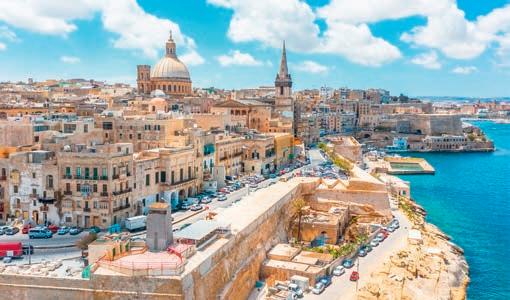
Frederick Catania was working for tuna farmer Ta’ Mattew Fish Farms on the Mediterranean island in April 2012 when the incident took place.

The court heard that he had dived to a depth of around 70m to work on fish farm cages when he suffered spinal decompression and was later admitted to hospital.
The incident left him with a permanent 75% disability and unable to work. He had sued his employer for damages, arguing the company had failed to ensure a safe system of work, the Times of Malta reported.



Another report said Catania was familiar with deep diving to work on fish cages, but this time he had only been provided with a standard oxygen cylinder instead of the specialist equipment needed for working at such depths.
The company denied this claim, adding that Catania had been paid his dues as well as some additional payments as a form of “charity”. It also stated that Catania’s contract stated he had to provide his own diving equipment. However, it was unable to provide a copy of the contract.
Catania was awarded €534,000 (£470,000) in damages, calculated on lost earnings, together with accrued interest.
Ta’ Mattew Fish Farms Limited was also ordered to pay court costs. It is not known whether the company plans to appeal.
THE Norwegian government unveiled its new salmon tax plans at the end of March, lowering the rate from the original 40% to 35%.
The concession did not impress Norway’s fish farmers, however, who described the package as “disappointing”.
Prime Minister Jonas Gahr
Støre and Finance Minister Trygve Vedum announced their proposals at a special press briefing on 28 March.


In the next few weeks, the salmon tax or “ground rent” proposal will go before the Storting, Norway’s parliament, when MPs are expected to vote it into law. The tax is retrospective, taking effect from 1 January this year.
Salmon companies already pay corporation tax at 20%, so their new full rate, after certain deductions, will be 57% instead of the 62% suggested at the budget in September.
The government said: “The [35%] rate will be based on the market value of fish at the end of the cage [production cycle], which the companies themselves set for 2023. From 2024, we aim to establish an independent price council.
“A minimum deduction [tax-free threshold] of NOK 70m (£5.5m) means that only companies with significant profits will pay the basic interest tax.”
Half the income from the tax will go to municipalities in the location of the farms.
Støre told journalists that although the basic model remained, the government, in coming up with the lower rate, had

listened to input from an earlier general consultation.
He described it as a businessfriendly proposal and said if the Conservatives opposed it, they would be seen as the party less friendly to business.



Norway’s biggest salmon farmers came out almost unanimously to condemn the plans. Mowi Chairman Ole-Eirik Lerøy told Seafood Norway’s annual conference in Bergen that salmon farming was not comparable to the other industries subject to a “ground rent” tax.
Mowi also said in a Stock Exchange message that the new plan was not much different from the old one. The company’s CEO Ivan Vindheim, in an interview with broadcaster CNN, said: “I believe when politicians see the negative consequences of this proposal they will change it. I am an optimist in the longer term – it just needs some time to persuade the politicians.”
SalMar said there was still time for the Storting to amend the proposals before the summer. It said: “SalMar submitted a detailed response to the public consultation process clearly and strongly opposing the proposed tax. The basis for the tax proposal assumes the salmon industry generates excessive returns compared to the risk involved, but this is not accurate.
“The entire tax proposal thus rests on failing premises. Therefore, the ground rent tax on aquaculture in Norway should be permanently set aside.”
Cermaq also said it was disappointed, maintaining the government had not taken into account the impact on support and supplier industry jobs.
Seafood Norway, one of the country’s main organisations representing employers in aquaculture and fisheries, described changes to the proposed tax as “disappointing”.
The organisation’s CEO, Geir Ove Ystmark, accused the government of not listening to or understanding the salmon farming industry and said bluntly: “This proposal changes nothing… [it] is not going to make any changes to the investment drought that occurred after the proposal was put forward last autumn.

“The industry has been clear that we have room to contribute beyond the many extra taxes the industry already pays and proposed a solution that would have given the community the income the government predicted.”
Sondre Eide, General Manager of salmon farmer Eide Fjordbruk, told regional broadcaster NRK Vestland that he was not happy with the tax.





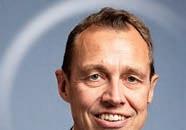



He argued: “There are no incentives for sustainable technology development. This tax will cause Norway to lose its competitive advantage against Iceland, Scotland and Canada.”


AKVA, the aquaculture technology and service group, saw its order book increase by around £40m last year, but it also recorded an accounting loss.







Presenting its annual report in March, AKVA said orders now stood at NOK 3,414bn (£262m) against NOK 2,890bn (£222m) a year ago.
Revenues rose by 8% to NOK 3,376bn (£259m), but profitability was negatively affected by restructuring costs, which meant the group reported a loss of NOK 131m (£10m).
AKVA, which describes itself as the global market leader in solutions and services to the fish farming industry, said it entered 2022 with “optimism, a solid order backlog and an excited pipeline of new projects”. It is located in 11 countries, including Scotland.
CEO Knut Nesse told shareholders that the business was hit by several cost-related headwinds during the year.

He said: “First, at the end of 2021, AKVA experienced somewhat challenging profit margins due to increasing costs from high inflation rates and global supply restrictions.
“This was further intensified during the first half of 2022 due to the war in Ukraine. Examples include increased freight rates, high energy prices, and increased price level on raw materials and key components in general.
“During the first half year, AKVA reported NOK 67m [£5.1m] in extraordinary costs related to the high inflation rates. In addition, onetime provisions of NOK 65m [£5m]

were made on certain sea-based and land-based projects.




“AKVA implemented several mitigating measures to manage the challenging situation, and the situation normalised somewhat in the second half of 2022.”

Turning to the thorny issue of tax, he added: “The implications from the [Norwegian] resource tax are uncertain... in the short term the resource tax has a negative impact on the activity level in the postsmolt segment in Norway and AKVA does not expect new investments in the post-smolt segment in Norway before the uncertainty related to the resource tax is concluded.
“The post-smolt market in Norway is a very important part of our organic growth strategy within the land-based segment.”
During the third quarter last year, AKVA announced a cost saving programme with an annual target of NOK 100. (£7.7m)
Nesse said: “This also includes a restructuring of our land-based business segment where the new blueprint organisation will be established at the headquarters at Klepp.The new organisation will then be located in the main marketplace for post-smolt and with same location as AKVA management, Sea Based and Digital organisations... we will gradually downscale our organisation in Denmark.”


He added that at the end of Q4 70% of the group’s cost saving target was achieved and said the remaining 30% will be implemented gradually in 2023.
LAND -based fish farmer Gigante Salmon has said in a Stock Exchange announcement that it has started drawing on a NOK 204m (£16m) construction loan facility. The move means the company is on track to start production later this year.

The loan was approved by the Sparebank 1 Nord-Norge in February 2021 and guaranteed by Eksfin, a government financial organisation that offers long-term financial assistance to the aquaculture and fishing industries, among others.




The company said development at Rødøy in the Nordland region is progressing according to plan, with production due to start in one of three basins this September.

The statement added: “Production will start as soon as the first basin is complete, as indicated in our timeline. Work on the other two basins will continue alongside production activities and is due to be completed in mid-2024.
“Limiting production to a single basin initially will provide us with valuable insight and experience with the finalisation of construction.”
Earlier this year, Gigante Salmon confirmed it was in a strong financial position, with long-term financing granted for both the development and operational phases, including working capital of NOK 140m (£11.5m) for building up biomass.
“We are satisfied that the investment and progress in Gigante Salmon Rødøy is going according to plan, and we are looking forward to the first release of smolt in September,” said Chief Financial Officer Rune Johansen.


Gigante Salmon is part of a wider family-owned aquaculture business and holds a licence to produce just over 13,700 tonnes of salmon.
site

areas, environmental assessments, science-based tools and modelling, and increased economic development programmes – all of which support the growth of a US aquaculture industry.
In addition to the funding request, SATS has also requested that the Committees include specific language within the related Explanatory Statement of the CJS Appropriations Act stating the Committees recognise the significant potential for development of American offshore aquaculture to increase US production of “healthful, sustainable and affordable seafood”.
Through Seafood (SATS) is calling on the US Congress to support an increased funding package aimed at growing the country’s aquaculture sector.
SATS has written to the chairs and ranking members of the US House and US Senate Appropriations Subcommittees on Commerce, Justice, Science and Related Agencies, urging Congress to support annual funding for the Aquaculture Office of the National Marine Fisheries Service (NMFS).

The NMFS is part of the National Oceanic and Atmospheric
Administration (NOAA), the government agency that oversees marine environmental issues, among a wide range of other responsibilities.
The letter requests that the Committees support a requested $25m (just over £20m) in annual funding for the NMFS’s Aquaculture Office, which includes funding for NOAA’s Five-Year Strategic Plan for Aquaculture. The plan is intended to guide the agency’s efforts to enhance the growth of sustainable US aquaculture from 2023 to 2028.
The requested funding would also support the agency’s continued work on aquaculture opportunity
“The funding requested for the NMFS Aquaculture Office is essential [for] supporting growth of the American aquaculture industry,” said Drue Banta Winters, Campaign Manager at SATS. “By prioritising domestic aquaculture, Congress will support the growth of an American seafood community that is resilient to economic and climate changes, and is part of a holistic approach to a greater sustainable food strategy.
“We strongly urge Members of Congress to provide the necessary funding required to establish a robust American aquaculture industry to increase our domestic supply of healthful, sustainable and affordable seafood.”
MOWI chose the key trade show Seafood Expo North America (SENA) to launch a number of new consumer products.
Three years after the launch of the Mowi brand – at the height of the Covid-19 pandemic – the company now has more than 20 salmon products ranging from fresh skinpacked hot and cold and breaded fish on offer.
It said SENA, held in Boston in March, the largest such event in the US, was the perfect occasion to celebrate the brand’s trajectory.
This year, Mowi introduced Atlantic salmon portions to US consumers, which it says brings a variety of flavoured butter pucks to enhance the already delicious flavour of salmon.

This new line was unveiled in the New Product Showcase Exhibitor segment at SENA.
Diana Dumet, Marketing Director at Mowi Americas Consumer Products, said: “With the Mowi brand, we want consumers to recognise the bounties of farm-raised Atlantic salmon and encourage them to try the extensive variety of our product line.
“US consumers enjoy salmon on many different occasions:
as an everyday meal and as an indulging experience [on] a special occasion. In the similar way that some consumers choose a different quality of their favourite protein for entertaining vs an everyday home meal, Mowi has expanded its horizons to meet different price points and eating occasions.”
Andreas Johler, Managing Director of Mowi Branding, said Mowi was now present in 18 markets and had achieved its goal of becoming “a global brand”.
COOKE Aquaculture has been given the green light for a land-based post-smolt facility in New Brunswick on Canada’s Atlantic coast. The provincial government of New Brunswick has granted a “Certification of Determination to Proceed” to Cooke subsidiary Kelly Cove Salmon Ltd (KCS) for the construction of a proposed CAN $72m (£43m) land-based Atlantic salmon post-smolt aquaculture facility in Bayside, a coastal community in the province’s Charlotte County.


Located in the Champlain Industrial Park alongside the Passamaquoddy Bay, the new facility will be a world-class recirculating aquaculture system (RAS), Cooke said.
KCS began planning the high-tech project in 2017 and received environmental impact assessment approval earlier this year for ground-source wells to supply the facility with water. Associated with this facility are two water pipeline corridors and a marine loading facility.
“Hybrid systems, involving a mix of land and marine-based fish farming, will continue to be part of our future. We have been operating land-based salmon hatcheries and marine farms sustainably for 38 years,” said Joel Richardson, Vice-President of Public Relations at Cooke. “Innovative scientific technologies bring a new opportunity for greater production in ocean waters by shortening the time Atlantic salmon spend in marine cages.”
In March last year, the province’s Agriculture, Aquaculture and








Fisheries Minister, Margaret Johnson, published the New Brunswick Finfish Aquaculture Growth Strategy 2022–2030. It aims to encourage responsible development in the province’s finfish aquaculture sector with a focus on land-based production.
It is expected the multi-phased project will take three years to complete and create more than 340 direct construction jobs, and 222 indirect and induced jobs.
The project team for the new aquaculture facility includes two local suppliers, Sorensen Engineering Ltd of Saint Andrews and Sweeney International Marine Corp (SIMCorp) of St Stephen.

been working with the Center for Cooperative Aquaculture Research (CCAR) in the US on this initial batch, while it prepares for the construction of the Maine facility.
Kingfish Maine Operations Manager Megan Sorby said: “We have worked three long years to arrive at this point – harvesting our first Dutch yellowtail from Maine and completing all our permits for our land-based Jonesport facility.
This small limited release batch of yellowtail from Maine will be distributed and served at restaurants in Maine, Boston, Washington DC and California over the next two months.
Maine-based company Bristol Seafood, which recently announced its B Corp. certification, is processing the limited reserve batch at its Portland facility.
THE Kingfish Company is celebrating its first harvest of Dutch yellowtail produced in Maine, in the north-eastern US.
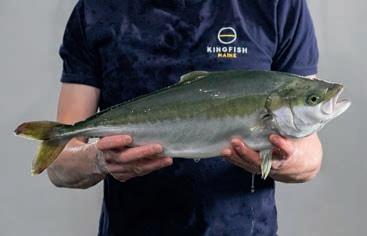
The first small batch of fish will be distributed to the restaurant trade, even though the company’s full-scale recirculating aquaculture systems (RAS) facility there has yet to be built.
The group’s subsidiary, Kingfish Maine, has
“This would not be possible without the collaborative work with our team at Kingfish Zeeland and our crew here at CCAR. We are excited to bring the first Dutch yellowtail from Maine to the market.”
It was almost three years ago that Kingfish Maine began deploying the same advanced RAS technology at CCAR to raise fingerlings as its sister company in the Netherlands uses for yellowtail production.
Bristol Seafood CEO Peter Handy said: “We are proud that the Kingfish team is entrusting us with processing and packaging its first Maine harvest of sustainably raised Dutch yellowtail. We look forward to supporting Kingfish Maine as the company fully develops its facility in Jonesport.”
Kingfish CEO Vincent Erenst added: “Our first Maine harvest is a milestone for the Kingfish Company. Our US facility will mirror the operational excellence proven in the Netherlands.”
THE head of Proximar Seafood, the company building a landbased Atlantic salmon farm in Japan, has predicted that global unrest will see an increase in countries wanting to step up their food security.


He also confirmed that the company’s capital expenditure on the facility, near the foot of Mount Fuji in Japan, was still within expectations and construction has been progressing according to plan. The hatchery and nursery building were handed over to Proximar in October.
Presenting Proximar’s annual report, Chief Executive Joachim Nielsen told investors that self-sufficiency in international food trade had not been given a high priority in recent decades.
He went on: “But following geopolitical instability both in Europe and Asia, we expect to see increased focus on and strategies for locally produced food.
“This topic will be a top priority on the national agenda. Japan’s self-sufficiency rate has been falling for decades and is now becoming a substantial concern.
“According to an article in the Financial Times (8 September 2022) Can Japan feed itself? Japan has one of the lowest self-sufficiency rates compared with other major countries – approximately 38% today.”
“He added: Proximar is proud to be playing a key role in local food production, aiming to be a leading provider of sustainably produced seafood in Japan.”
Nielsen continued: “The hatchery and nursery building was finished in October and we were able to start the production stage as planned when the first batch of eggs was brought into the hatchery.

“We are now officially a production company of Atlantic salmon. The production stage requires us to have more colleagues in important operational positions.
“We have successfully recruited highly qualified and motivated people for key manager positions in Japan, and will continue with further recruitments to build our production team and other operational positions.”
The report states that the company’s operations started in the fourth quarter of 2022 when the first eggs were inserted. The second batch arrived in December and monthly batches are planned going forward.

Through the past 12 months, Proximar:

• successfully raised a convertible loan of NOK 250m (£19m) in a challenging financial market





• increased the JA Mitsui construction financing by another JPY 750m (£4.7m) to a total of JPY 3.25bn (£20.3m);
• further strengthened its partnership with distributor Marubeni with a firm agreement to take up the entire volume from Proximar’s first facility for 10 years (Marubeni has also invested in Proximar’s convertible bond); and

• was awarded the highest sustainability rating by the Japan Rating Agency (JCR).

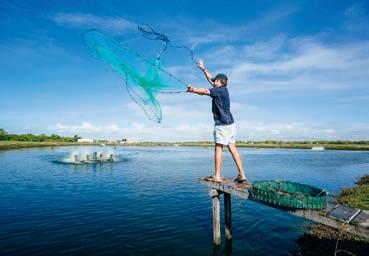

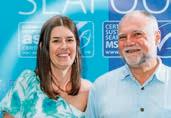





PACIFIC Reef Tigers, a prawn farm near Ayr in north Queensland, has been named as Best Responsible Producer in the Aquaculture Stewardship Council’s annual Sustainable Seafood Awards in Australia. The company was praised for its innovative water quality control system that cleans wastewater to a level where it can be reused, reducing nutrient pollution to below the global best practice of 5mg/ litre nitrogen and 1mg/litre phosphorus. The process is both carbon neutral and chemical free.
The ASC awards took place on 27 March at Melbourne Zoo. Also recognised at the event was shellfish farmer Yumbah, which took home the ASC Above and Beyond Award for its Indigenous engagement
and measures to reduce energy use, packaging, and plastics.Yumbah was also highly commended in the ASC Best Responsible Producer Award category for its integrated approach to managing and communicating environmental responsibilities. Caleb Trenberth, Propagation Manager at Yumbah, was also highly commended for the ASC Young Person in Aquaculture Award.
Yumbah is Australia’s leading sustainable and responsible abalone farming company, with several ASC-certified abalone farms across South Australia,Tasmania and Victoria. Taking home the ASC Best Retailer Award was ALDI Australia, which was recognised for its overall approach to responsible reporting and policies. Wollongong seafood store Harley and Johns was highly recommended for the same award.
In addition, ALDI Australia’s Specially Selected smoked rainbow trout fillets won the ASC Best Product Award.
The KB Food Company won the ASC Best New Product category with its innovative product, Fish Creatures. This playful and educational product
is specifically designed to engage children in the world of seafood and teach them about responsible and sustainable fishing practices.
The ASC Young Person in Aquaculture Award went to Jody Mulholland from Proserpine, Queensland, an employee at Tassal who has made incredible strides in enhancing sustainability management at Tassal’s ASC-certified Proserpine Prawn farm.



Tassal was also highly commended in the ASC Above and Beyond Award category for its efforts to reduce greenhouse gases at its ASC-certified salmon farms in south-eastern Tasmania., where a shift to electric pumps has resulted in reductions in noise and a million litres of diesel.
Last but not least,Tasmanian, Hobartbased seafood supplier and restaurant owner Mures was acknowledged for its ongoing commitment to responsible aquaculture and making information about responsible aquaculture production available to consumers in both its retail and food service outlets, winning the Aquaculture Champion 2023 Award.
THE Global Seafood Alliance (GSA) has announced that Brian Perkins is no longer its Chief Executive Officer.





Wally Stevens will be acting as the GSA’s interim CEO until a replacement is found, the statement said. Stevens previously acted as GSA’s Executive Director and CEO.

The GSA’s statement concluded: “More details will be forthcoming.”
Perkins joined what was then the Global Aquaculture Alliance (GAA) as Chief Operating Officer in March 2021. In January 2022, he succeeded Stevens, who retired at the end of December 2021, as Chief Executive Officer.

Perkins is an executive with 40 years’ seafood experience in the certification space as well as in managing events and media. Prior to joining the GAA/ GSA, he was Regional Director, Americas, for the Marine Stewardship Council (MSC), one of the world’s leading wild fisheries certification programmes. Previously, he headed seafood expositions and publications at Diversified Communications, which runs trade events such as Seafood Expo Global, Seafood Expo North America and Aquaculture UK.
announcement, Atlantic Sapphire said the company could potentially issue a further 20 million new shares at the same price of NOK 5.00 per share.
The following existing shareholders had pre-committed to subscribe for offer shares in the private placement:

FISH farming companies Mowi, Grieg Seafood and Cermaq have separately filed applications for a judicial review of the Canadian federal government’s decision not to renew aquaculture licences for the Discovery Islands region of British Columbia.
In February, Joyce Murray, Minister for the Department of Fisheries and Oceans (DFO) and the Canadian Coast Guard said that the licences held by larger companies in the region, also known as the Laich-kwil-tach and Klahoose First Nations territories, will not be renewed.



This followed an earlier decision to shut down salmon farming in the region, which had been overturned by Canada’s Federal Court in April last year.
On behalf of Grieg Seafood British Columbia (BC), the company’s Communications Director Amy Jonsson said: “Grieg Seafood BC Ltd has filed a Notice of Application for Judicial Review regarding the recent Discovery Island licence decision, announced by the Minister for the DFO Joyce Murray on February 17, 2023. The filing will allow Grieg to access DFO documents, which will provide insight into the Minister’s decisionmaking process which is important to understand for future planning and development.”
She added: “Grieg Seafood BC will continue to work with local First Nations, communities and suppliers to ensure that it continues to operate in a sustainable manner and meets the expectations of both the regulator (DFO) and the Nations in whose territories it operates.”
Ian Roberts, Director of Communications, Mowi (Scotland, Ireland, Canada), told Fish Farmer: “Mowi has an obligation to protect its employees, fish and business from significant harm caused by unlawful and unreasonable government decisions. The continued absence of procedural fairness afforded by both ministers throughout the process of licensing renewals within the Discovery Islands region leaves our company no other option than to seek the court’s intervention.”
FLORIDA salmon farmer Atlantic Sapphire has raised the equivalent of US $55m through a private placement on the Oslo Stock Exchange.
The placement involved the sale of 199 million new shares, at NOK 5.00 (£0.39) per share, raising NOK 595m (£46m).
Atlantic Sapphire said the net proceeds from the private placement would be used to provide the company with sufficient financial runway, including a buffer, to achieve phase 1 steady-state production and profitability. Any remaining cash buffer may be used by the company for its phase 2 expansion.
The company had engaged DNB Markets and Carnegie to facilitate the equity-raising exercise.

In a further stock exchange

• Nordlaks Holding AS, one the largest and most profitable familyowned salmon farming companies in the world, for the NOK equivalent of £8m;
• Strawberry Equities AS for the NOK equivalent of £5.2m;
• Blue Future Holding AS owned by EW Group, a leading global provider of animal genetics, nutrition and health products, for NOK 50m (£3.9m); and
• Joh Johannson Eiendom AS, also for NOK 50m. (£3.8m).

Atlantic Sapphire has also indicated it is potentially willing to sell its firedamaged Danish facility.

The company has begun demolishing the RAS site, which was destroyed by fire in September 2021, and said it was “exploring new possibilities”, possibly a new RAS operation, which it said was cheaper to establish in Denmark than elsewhere.
Meanwhile, the We Wai Kai (Campbell River) First Nation is also seeking a judicial review of the decision. Dallas Smith, spokesperson for The Coalition of First Nations for Finfish Stewardship, said: “The Wei Wai Kum and We Wai Kai First Nations sent a thoughtful proposal to the DFO in November to re-issue some licences in their core territories. They put forward a cautionary approach to explore how and if finfish farming could be part of their Nations’ overall vision to manage their marine space. This decision to deny all licences in their territories has sent the Nations back to the drawing board in that regard.”
When the latest decision was announced in February, it was welcomed by a number of environmental organisations. Margot Venton, lawyer and Nature Program Director with Ecojustice, said: “The minister’s precautionary decision to limit fish farms in a key migratory route for highly vulnerable wild salmon populations is a critical step in giving wild salmon an opportunity to recover and thrive for generations to come.”
Below: Discovery Islands, British Columbia


Fish farming giant Cooke Seafood has announced that it has entered into a binding purchase agreement to acquire Slade Gorton, one of the largest distributors, importers and producers of fresh and frozen seafood in the US.
The new acquisition has a proud history. Thomas Slade Gorton, Jr. began as a fisherman’s apprentice aboard schooners fishing on the Grand Banks off Newfoundland, Canada, and founded the company in 1928. His son, Michael Gorton, Sr, headed the company for over 50 years, and Slade Gorton will continue to be led by fifth-generation family members Kim Gorton, CEO, and her brother, Mike Gorton, Jr, EVP, Business Development, who will both remain in their roles.
Cooke and the incredible global company his team is building. We are excited to join forces with the Cooke family of companies to take the Gorton family’s legacy forward.”
Slade Gorton currently offers more than 800 premium seafood products and maintains long-standing partnerships with hundreds of leading North American customers.
THIS will be the third major purchase by Cooke in less than 12 months after acquiring Tasmanian salmon farmer Tassal and the large European shrimp and prawn producer, Morubel NV, last summer.

The group also has extensive salmon farming operations in Scotland.
Based in Waltham, Maryland, Slade Gorton is a long-established business founded 95 years ago.
Cooke said that Slade Gorton is known for its deep industry expertise, unmatched customer service and its mission to “bring safe and sustainable seafood from around the world to America’s table”.
Slade Gorton said: “Over nearly a century, Slade Gorton has built a robust and resilient world-class supply chain in support of our family’s passion for making sustainable seafood accessible to everyone.
“As the world has evolved over the past several years, it became clear that to accelerate our mission and impact, it made sense to join forces with a diverse, vertically integrated company run by people who share our family values and vision for reshaping the consumer’s experience with seafood.“
Slade Gorton CEO Kim Gorton added: “There could be no better fit than Glenn
CRETEL, Belgian manufacturer of food processing equipment and washing and drying solutions, is launching its new generation of standalone fish skinners. The F460M fish version will replace the older and proven 460VH model.
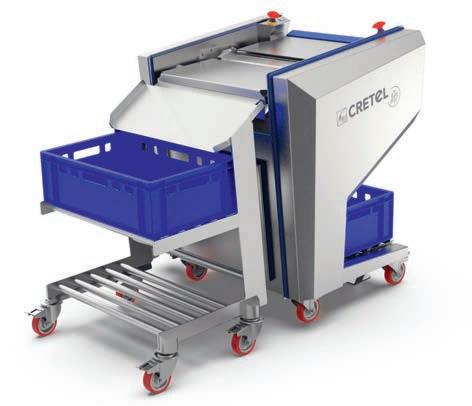
The F460M is robust and equipped with a safe 24-volt foot
switch or a fixed foot pedal on the frame. Compared to the last generation, the company says, it is more hygienic and easier to clean and handle. It comes with a bolted skinning shoe for optimal knife clamping, a new self-aligning assembly for the heart of the machine and a sturdier, more robust foot pedal.
For further information, call 0032 9376 9595 or email info@cretel.com
CEO Glenn Cooke said: “Cooke and Slade Gorton share a passion for ensuring that everyone has an opportunity to enjoy delicious, nutritious and sustainable seafood whether dining at home or in a restaurant.
“We will build on the expertise, innovation and deep commitment to its customers’ success that Slade Gorton is so well respected for.
SALMAR is to close a large coastal slaughterhouse at Rørvik in central Norway with the loss of more than 100 jobs.
The company said the facility would have required an investment of NOK 250 million (£20m) to bring it up to standard.
“Such an investment is not advisable with the ground rent tax,” the company added, referring to the incoming tax on Norway’s fish farmers.
The slaughterhouse is operated by SalmoSea. and provides slaughtering services to SalmoSea’s co-owners, SalmoNor and Bjørøya fish farming, as well as other producers. SalmoSea installed a new production line in 2019, which increased the daily capacity to 260 tonnes of salmon.
SalMar, through its ownership of SalmoNor, is the main shareholder of SalmoSea. SalMar said it regretted the decision to close the slaughterhouse but it had little choice.
“Slade Gorton has built a robust and resilient world-class supply chain ”Above: Glenn Cooke and Kim Gorton Above: The F460M, a new generation standalone fish skinner by Cretel
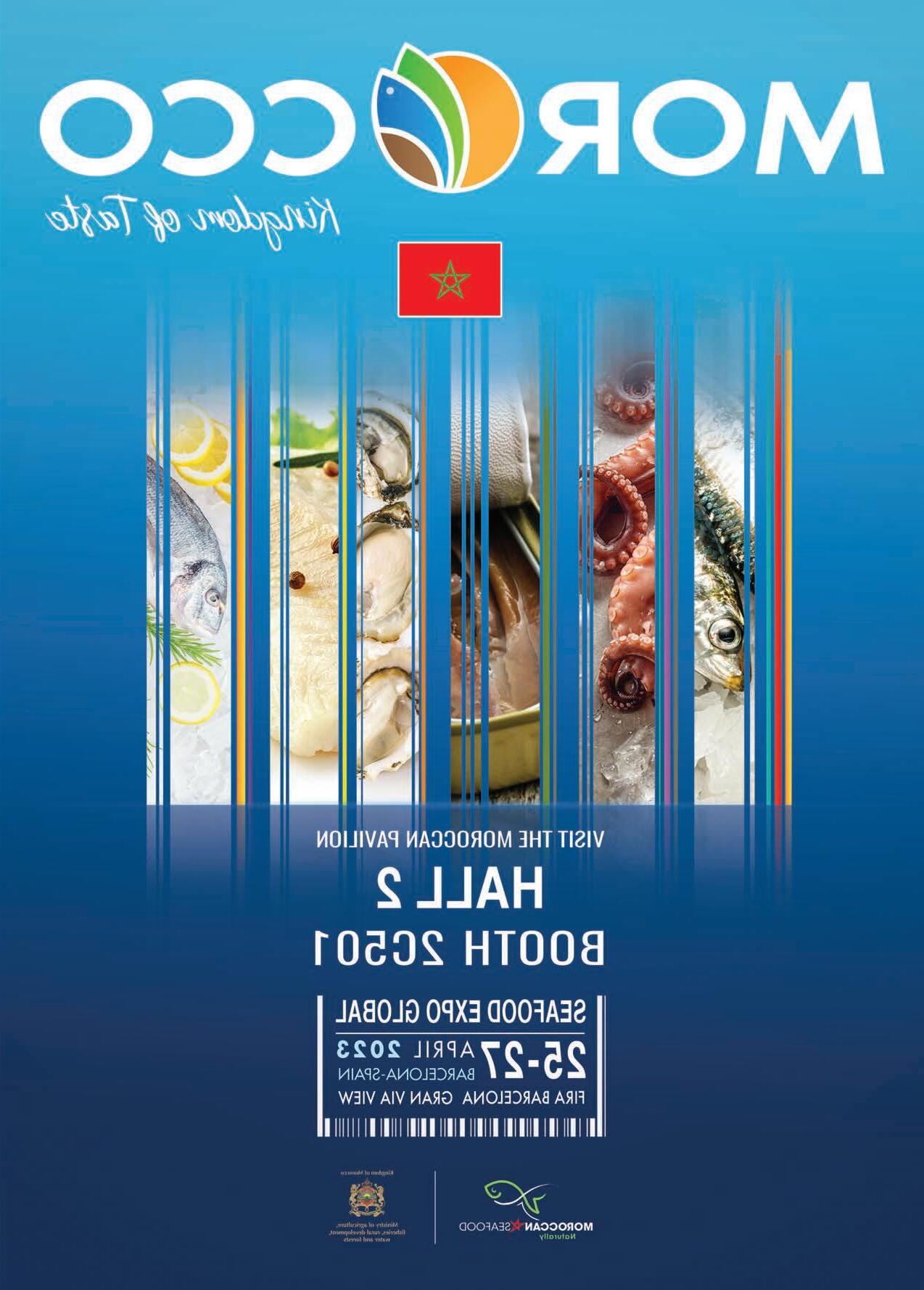














The world’s biggest seafood trade fair is bigger than ever. This April, Seafood Expo Global/Seafood Processing Global (SEG) returns to Barcelona, where it made its debut last year after many years of being based in Brussels.
SEG takes place over 25–27 April. It will be the show’s largest event yet, with 49,299m3 of exhibition space allocated – that’s 24% more than last year and 21% more than the biggest show so far, which was held in Brussels in 2019.

The event, at the Gran Via de Fira de Barcelona exhibition centre, will feature over 2,000 exhibiting companies from 87 countries and will have 68 regional and country pavilions.


Last year, potential numbers were hit by two factors: first, the war in Ukraine, which meant there was no representation from Russia or Belarus, and only one company from Ukraine; and strict Covid-19 restrictions in China, which prevented most Chinese companies from sending people abroad.
This time, while the war continues, the lifting of travel restrictions by the Chinese government means Chinese businesses will be represented amongst the expected 2,000-plus exhibitors from 87 countries.
The 2023 show will welcome 776 first-time exhibitors, including
Atunes y Lomos, Blumar, Golden Fish Sarl, Grøntvedt Group, Metarex Spa, North Pacific Seafood Pte Ltd, Pereira Productos del Mar and Pickenpack Seafoods GmbH, all exhibiting at Seafood Expo Global. Activa Food Tech SAU, Aquatiq AS, Lineage Logistics and Van de Velde Packaging Group will be participating for the first time at Seafood Processing Global.
Buyers attending the event include supermarkets, hypermarkets, restaurants, retailers, importers, distributors, wholesalers and representatives from the hospitality industry.
Liz Plizga, Group Vice-President with SEG organiser Diversified Communications, says: “The event presents the industry with a valuable platform to conduct business on a global scale and provide a significant positive impact on the local economy.
“For three days, we will once again bring together industry buyers and suppliers from all corners of the world to build business relationships, find new products, equipment and service solutions, explore current trends, and engage in discussions about the immediate and future challenges for the seafood industry.”
The expansion of the 29th edition of SEG will bring a boost estimated at more than €150m (£132m) to Barcelona, Plizga adds.

Fira de Barcelona’s General Manager, Constantí Serrallonga,




comments: “Seafood is another example of how an event arrives at our venue and in the city to consolidate itself and grow, boost business, and be a driving force for its participants and be an engine of its industry and ecosystem. Hosting a world-leading seafood event reinforces the positioning of the fair institution in the field of food, a key sector for the economy.”
In 2023, the conference programme will offer more than 20 educational sessions that will address the principal challenges, opportunities and solutions that are transforming the seafood industry.
More than 85 leading international experts from the industry will share practical and theoretical knowledge of the most current issues for the seafood industry. Megan Greene, Global Chief Economist at Kroll, Financial Times columnist and Senior Fellow at the Watson Institute for International and Public Affairs at Brown University, will deliver a keynote presentation entitled “Navigating the Global Polycrisis” on the second day of the Expo.
Later in the day, results of an international benchmarking report, “International Retail Trends in Seafood”, will be unveiled during the session.






This year’s SEG will also see the return of a pavilion from the region of Galicia in north-western Spain. The Galicians stayed away from Barcelona in 2022, preferring to focus on their own seafood event, but they will be present this year to spread the message “Galicia sabe amar” (“Galicia loves the sea”).

SEG will feature a total of 68 regional and country pavilions, from Morocco to Chile. Australia, Saudi Arabia, the Seychelles and Solomon Islands will have new country pavilions, while Japan, South Korea, Taiwan and the US will be represented with new regional pavilions.


As ever, Scotland will be well represented. The Scottish Pavilion, coordinated by industry body Seafood Scotland and Scottish Development International (SDI), will feature 19 producers and others will be hosting their own stands.

This year, the Scottish Shellfish Marketing Group, representing a cooperative of 19 shellfish firms, and steelhead trout producer Kames Fish Farming will be presented at SEG for the first time.








Seafood Scotland’s Head of Trade Marketing Asia, Europe & Middle East, Natalie Bell, says: “This year’s SEG will be bigger and better than ever!”
















The event is an important one for the industry, she stresses: “SEG is a platform for producers to meet new and existing buyers, such as the large supermarket chains. It’s where deals for the year are done and there is always a big buzz on the Scotland stand!” The Scottish Pavilion will also feature presentations from seafood educators Catriona and John Frankitti, and cookery demonstrations involving Scottish produce led by top chef and culinary consultant Steve Walpole.
For further information about Seafood Expo Global/Seafood Processing Global and to register, visit: www.seafoodexpo.com/global. The complete conference programme can be found on the event website at www.seafoodexpo. com/global/conference-program. This year, video recordings of the sessions are included in the conference registration.
There is always a big buzz on the Scotland stand!



We are fortunate in Scotland to have two governments that recognise the extraordinary contribution of Scottish farm-raised salmon. In both Westminster and Holyrood, ministers have championed our sector, our workforce and our powerful impact on the economy.
I hope to have early talks with Humza Yousaf as he takes up the role of First Minister following Nicola Sturgeon’s resignation, and to welcome him to a farm to get his feet wet. We will offer a pair of First Ministerial wellies.
Yousaf was announced as the SNP leader at Murrayfield, becoming the first member of a political party to find out they had won an internal leadership contest at the home of Scottish rugby since yours truly in 2008, when I was elected as Scottish Lib Dem leader.
Yousaf was just 23 at the time and it would be three years before he first became an MSP, so it’s safe to say a lot has changed in politics since then.
But I’m extremely confident that the long-standing relationship between the salmon sector and the Scottish government in all its various incarnations will continue.
During the recent SNP leadership contest, I wrote to all three candidates to outline what measures our sector wants to see from ministers.
Given that Scottish salmon adds £760m annually to the country’s economy, as well as being the UK’s biggest food export, and generating more than 2,500 direct jobs in fragile coastal communities and a further 10,000 Scottish jobs through the supply chain, I expect our asks to be near the top of the Bute House in-tray.

One of the key issues for our member companies right now is the rural housing crisis, which I have previously addressed on these pages. We have the perfect storm of unaffordable homes, empty homes and those properties that are available are being snapped up by investors. The lack of affordable housing means not being able to live near where you work and it separates families, contributing to the
depopulation of our island communities. We know that in many remote parts of Scotland, salmon farms are what keep the local businesses and communities going. So I set out in my letter to Humza our proposal that £10m of the rents paid by salmon farmers to Crown Estate Scotland be ringfenced for direct investment in rural housing.
And not just housing for salmon farmers –housing for the entire community.
We firmly believe that more of the money we pay to our landlords should be invested directly in coastal communities.
I was encouraged to see that during the SNP leadership campaign, Humza took the time to address the issue of rural housing.
He said: “Those working in hospitality, tourism or rural communities also face problems finding affordable housing in local communities, which can really harm local economies.”
I therefore look forward to ensuring that this priority issue is actioned now that Humza has the levers of power.
The second main issue I raised with the SNP hopefuls was the Griggs review of aquaculture.
Professor Russel Griggs published his conclusions in February 2022, stating that the current setup needs urgent change to deliver on the full potential of the blue economy. We agree.
The consents and licensing process for
There’s lots we want to discuss with Yousaf and his team, including Mairi Gougeon who we are delighted to see remain
salmon farms is unnecessarily long and complex, with several regulatory bodies involved, leading to delays, uncertainty, unnecessary cost and bureaucratic procedures.
If the system is streamlined, as Griggs recommends, our sector can be more competitive on the global arena.
The Scottish government immediately accepted the recommendations and the report itself urged reform within 12 months. That timeframe has already passed.
So our ask of the new First Minister and his Cabinet is for progress on implementing the Griggs recommendations as a matter of urgency.
Another area which I’m sure will dominate our engagement with the Scottish government in the months ahead is the contentious idea of Highly Protected Marine Areas (HMPAs).
As part of the Bute House Agreement with the Scottish Greens, 10% of coastal waters around Scotland would be closed to human activity.
A government consultation comes to an end soon, and while Yousaf’s defeated rival, Kate Forbes, said she would scrap the idea, it now remains on the cards following the SNP leadership result and the renewal of the party’s partnership with the Greens.
We ask that the government thoroughly considers the social and economic impacts of this policy on the sectors, industries and communities that operate in Scotland’s coastal regions, as well as those that are impacted through the supply chain.
That is yet to happen and if the government does proceed with this policy, a full understanding of the impact on business, livelihoods and communities is essential.
Humza can hardly fail to have noticed that concerns over this policy are not just confined to the salmon sector.
Highlands and Islands local authorities, the fishing industry and much of coastal Scotland has questioned this approach. It needs a radical rethink.
We are all in favour of biodiversity in the marine environment, but other government policies expect the seafood sector to deliver food security, contribute to international trade and maintain jobs in sparsely populated areas. Humza Yousaf’s new government needs to decide what it is about.
Finally, I also raised the “Sea Lice Risk Framework” in my letter to Humza.
In April 2020, the Salmon Interactions Working Group (SIWG) published recommendations that sought to drive progress on farmed and wild salmon interactions.
The Scottish Environment Protection Agency (SEPA) has been designated as the lead body responsible for this policy area and we wish to ensure that both it and the government deliver on the recommendations of the SIWG.
This included an advisory planning framework for local authorities to use in the determination of development applications.
We remain concerned that SEPA continues to exceed its brief in this area, developing a highly complex, restrictive and scientifically questionable regulatory framework, which may have a considerable impact on our sector.
So there’s lots we want to discuss with Humza and his team, including Mairi Gougeon who we are delighted to see remain as Rural Affairs Secretary.
We have a very positive relationship with her and look forward to continuing our strong relationship with the Scottish government. Tavish Scott is Chief Executive of Salmon Scotland, the body representing the Scottish salmon sector.
See also Environment, page 38



While watching one of David Attenborough’s many fantastic nature documentaries recently, I was struck by a segment on the ecosystem of bees and their beehives that perfectly captured the truly integrated and collaborative ways that they work. Each bee goes into the hive with purpose and, in turn, contributes to a collective and productive goal, before heading back out into the wider world to support pollination and the propagation of plant life.
This insight into the natural world got me thinking about the human equivalent of such a situation – although not necessarily with a queen bee at the core. There is a great deal of value in people with a common purpose getting together to inspire one another and take ideas and wisdom out to other groups and settings. To apply the analogy to aquaculture, it is about finding the opportunities to foster collaboration across different geographies, specialisms and parts of the aquaculture supply chain – and, forgive the pun, creating a buzz at the same time.
Events and conferences are a prime example of that in action. We are fortunate to have a sector that is engaged with the opportunities they present, and a network with incredible knowledge and expertise more than willing to bring it to the table.
This year we have two big opportunities for people with an interest in Scottish aquaculture: May’s Sustainable Aquaculture Summit in Glasgow and the supply chain trade show, Aqua Nor, in Trondheim in August. These events will attract international audiences, and in the case of Aqua Nor specifically an anticipated 25,000 visitors from more than 75 nations.








Together with Highlands and Islands Enterprise and Marine Scotland, the Sustainable Aquaculture Innovation Centre (SAIC) is working on bringing the largest ever Scottish delegation to the Trondheim trade show. The focal point will be the 200m2 Scottish Pavilion, where a range of businesses, from SMEs and startups to university spinouts,

will be exhibiting across 20 pods. Only a few of these spaces remain, but there are still opportunities to join the delegation and, of course, visit the pavilion.
This collaboration represents the first official Scottish delegation to visit at Aqua Nor since 2017, when around 60 people joined us. This year, we expect around 100. Scottish organisations already signed up include experts in marine research, cleaner fish, satellite communications, acoustic technologies and more.
There’s something for everyone at Aqua Nor. First and foremost, it’s a business opportunity for the supply chain, but it is also about making new connections, exploring global innovation, checking out ideas and sharing knowledge with international peers. Underpinning all of that is Scotland’s collective ambition to grow sustainably. I hope that global conversations about policy and regulation across the major seafoodproducing nations will create a buzz in favour of sustainable growth that benefits Scottish companies, innovators and researchers.
Whether you are an introvert or an extrovert, research has shown that the value of networks is more than just gathering a group of like-minded individuals or members in one place at one time. SAIC wants to create environments, and communities of people, where network intensity can build – by that, we mean multiple valuable interactions between different people within the network for a range of purposes. Visiting the beehive isn’t a one-off.
This year’s events, whether in Glasgow or Trondheim, are a great opportunity for that to happen. By increasing network intensity in this way, we can inspire greater cross-pollination globally, supporting even more innovation and adoption across the entire sector for the benefit of Scotland.
 Above left: Heather Jones
Above right and left: The Aqua Nor show
Above left: Heather Jones
Above right and left: The Aqua Nor show
There is a great deal of value in people with a common purpose getting together
International networking never fails to create a buzz, says Heather Jones




Demand is strong for skilled people in aquaculture and the level of opportunities in the sector reflects that


Our ambition when we launched HiJOBS back in 2015 was to give Scotland, and crucially the Highlands and Islands and rural communities, a dedicated recruitment website that showcases the breadth of career opportunities, promoting the region as one of the best places in the world to live and work.
With industry body Salmon Scotland estimating that the sector has created more than 10,000 jobs across the country, aquaculture has remained a key priority for us.

In the last two years, we’ve promoted 465 aquaculture-related jobs and the data from those job posts provides an interesting snapshot of recent sector recruitment.
Scotland’s aquaculture industry continues to experience a period of significant and increasingly rapid change. Driven by technological advancements, shifting consumer preferences and growing environmental concerns, we’re seeing a significant rise in demand for skilled professionals in the industry, alongside new career opportunities for those seeking to enter or progress within this exciting and dynamic sector.
Given the rapid rise in retail demand and exports in the last two years, particularly for Scottish salmon, and
subsequent investment and site expansion undertaken by the likes of Mowi Scotland and Bakkafrost Scotland, it may come as little surprise that HiJOBS saw the number of advertised aquaculture positions in 2022 soar by 28% compared with 2020, the first year of the Covid-19 pandemic.



Excluding overtime and bonuses, standard in many roles within the sector, the average median salary for aquaculture jobs advertised on HiJOBS in Q1 2023 was £26,500 per annum. This represents an increase of over 14% in the same period for 2022, making it one of the few industries that have managed to keep salaries at pace with the UK’s spiralling inflation last year.
This rise in average salaries reported by HiJOBS comes as no surprise to Donald Waring, Learning and Development Manager, Mowi Scotland, who agrees that like many of their counterparts, his business has worked hard to keep salaries competitive. He says: “Needless to say, maintaining the attractiveness of the industry to entice new talent and try to reduce the impact of the cost of living crisis on employees is a huge priority. That said, it is just one part of the puzzle.
“Competitive salaries are great, but we also need to drive awareness and dismiss misconceptions on a local level,




sector.
especially with schools and parents. If our communities are better informed about the diverse range of jobs, career pathways and robust salary brackets that can compete with any Scottish city, we can significantly grow our appeal to young talent.”
One of the pleasing insights from the research was the recruitment of nine aquaculture SVQ Verifiers and Assessors. This is a clear indication of the increase of people within the industry undertaking skills training. While HiJOBS advertised for four aquaculture Modern Apprenticeships in 2022, across the board, commercial businesses are embracing more collaborative working, particularly with the University of the Highlands and Islands’ network to deliver SVQ Levels 3, 4 and 5 in Aquaculture. It’s no coincidence that Cooke Aquaculture highlights that over 15% of the company’s staff are completing Modern Apprenticeships in aquaculture, engineering and business administration.
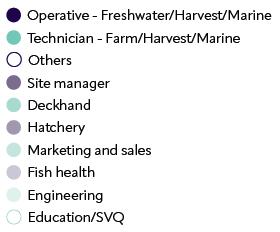

Aquaculture apprenticeships are also evolving. A welcome development is an increased focus on sustainability to ensure the aquaculture apprenticeship frameworks fulfil industry needs and remain fit for purpose, while providing viable career transitions away from oil and gas to low-carbon sectors such as aquaculture.
Our data shows that, alongside roles such as biologists and engineers, there was a significant demand for management and leadership roles, including site and area managers, planners and marketing specialists. This is in part brought on by the sector suffering from a talent drain of more senior staff, which is driven to a large extent by people reaching retirement age. To counter this, supporting younger talent to upskill and take on leadership roles is essential. While larger Apprenticeship Levy-paying employers such as Mowi Scotland or Scottish Sea Farms can benefit from up to £15,000 towards training, there is a huge opportunity for SMEs within the sector to take advantage of additional support available.
The Flexible Workforce Development Fund (FWDF) offers SMEs up to £5,000 training grants for upskilling and reskilling of existing staff. The only university with access to the Scottish government’s funded initiative, The Open University in Scotland, offers a vast range of quality courses that can complement the more practical SVQ qualifications. Subjects include business and leadership, project management, digital skills and sustainability. Speaking about the initiative, Tim Lewis, Business Relationships Manager, Open University (Scotland), said: “The FWDF presents a huge opportunity for employers within Scotland’s fish farming industry and
currently awareness is surprisingly low. The Open University works in partnership with businesses to develop a flexible and tailored solution that will help address their specific skills gaps. It’s a win-win, helping retain good staff, enhance productivity and build [the] business at little or no cost to the employer or employee.”
This has been the first time HiJOBS has looked to interrogate our aquaculture data. This is something that we plan to revisit on an annual basis, providing a snapshot of emerging new roles, average salaries and job locations, which can help inform the industry and prospective employees.

Aquaculture in Scotland is undergoing a significant period of change and it is an ever-moving target. These changes are creating new opportunities and demands for skilled workers in the industry, and those who are interested in pursuing a career in fish farming should be aware of these trends. As the industry continues to evolve, there will be continued opportunities for growth and innovation, making it an exciting field for those looking to make a difference in the world of seafood production.
Christopher Snelgrove is the Technical Director and Co-Founder of www.HIJOBS.net, the Scottish dedicated recruitment website. Over 80% of the Highlands and Islands workforce is now registered on HiJOBS, which has established specialisms across Scotland’s strongest and growing job sectors including aquaculture and renewable energy.
For more details on the Open University in Scotland’s Flexible Funding Development Fund support, visit www.open.ac.uk/business/ fwdf
Opposite, clockwise from top left: Mowi Carradale control centre; Kyle of Lochalsh farm, Scotland; Inchmore Hatchery Scotland; Chris Snelgrove, HiJOBS This page from top: Adver�sed aquaculture roles by job �tle 2020–22; Mowi Scotland staff member
Competitive salaries are great, but we also need to drive awareness and dismiss misconceptions



We want to hear from people who are as passionate about the planet and our products as we are.

Whether you are just leaving school, or are finishing college or university. Whether you are looking for your first job or have experience behind you. Whether you want to work in an office, on a farm, in a processing site or on a boat. Whether you want to commit full-time or prefer part-time hours.




When you take your first step with Mowi Scotland, you’re taking a step in your right direction.













































way we (mis)manage water on land is affecting our seas, but a new court case looks to challenge that.
By Nicki HolmyardFor too long in England and Wales, a deluge of untreated sewage has been discharged by water companies into our rivers and along our shores. This follows years of deregulation and multi-million pound budget cuts forced upon environmental agencies. The government has been slow to react to the issue, which affects all marine users, marine ecosystems and marine life.

It is particularly devastating for shellfish farmers, some of which have been forced out of business due to deteriorating water quality. Some have been left with no choice other than to depurate their shellfish before sale at great expense. However, while this process removes bacteria, it cannot destroy viruses and this is one reason why norovirus outbreaks can sometimes be traced back to the consumption of uncooked shellfish, particularly oysters.
The Shellfish Association of Great Britain (SAGB) recently initiated a major project that aims to improve the quality of our waterways. One of the intended outcomes of the project is a safe harvesting tool, which will provide useful information for shellfish
farmers and inform them of local risks.
The project comes on the back of longstanding concern about water quality, which the SAGB has been raising with the UK government and competent authorities for many years on behalf of its members.







The main problem with the UK’s sewage system is that we have developed a ludicrous practice of funnelling rainwater runoff into the same pipes as wastewater from toilets. The problems are compounded by not having large enough


People are concerned about the impacts of sewage entering our rivers and seas
tanks to collect all the waste. This means that every time it rains heavily, the system is almost guaranteed to overflow. The water companies are legally allowed to discharge untreated overflow through a network of 14,500 combined sewage outfalls within the parameters of their planning permission. This is happening more and more.
Water companies have failed to invest enough to tackle this problem and the work they have done is inadequate. An investigation in 2021 by the Environment Agency found that sewage monitors installed by UK water firms did not work 90% of the time or had not been installed at all. The data also showed that there were 28,700 discharges into shellfish waters during the year, with a total duration of just over 200,000 hours, as well as 24,800 discharges into bathing waters with a total duration of 162,000 hours.
In the summer of 2022, dozens of beaches were again closed to swimmers due to the high levels of pollution.
Time
For the Marine Conservation Society, Richard Haward’s Oysters and


They would like to see the “polluter pays” principle working in practice.
Together with support from the Good Law Project, the trio have brought a case against the government to compel it to rewrite its Storm Overflows Discharges Reduction (SODR) Plan, published in August 2022, and to take tougher action to stop water companies from dumping raw sewage into our coastal waters.
On 14 February, the Good Law Project announced its delight at being given a hearing in the High Court for its legal challenge.
“We believe this could be one of the UK’s most significant environmental law cases in recent history. Our legal challenge revives an old common law legal doctrine – the Public Trust Doctrine – to force government to take the protection of our rivers
Opposite from top: Protesters against the dumping of sewage at sea, Whitstable, Kent; The Royal Courts of Jus�ce, London; Sewage ou�low
Above: Shucking oysters, Richard Haward’s Oysters
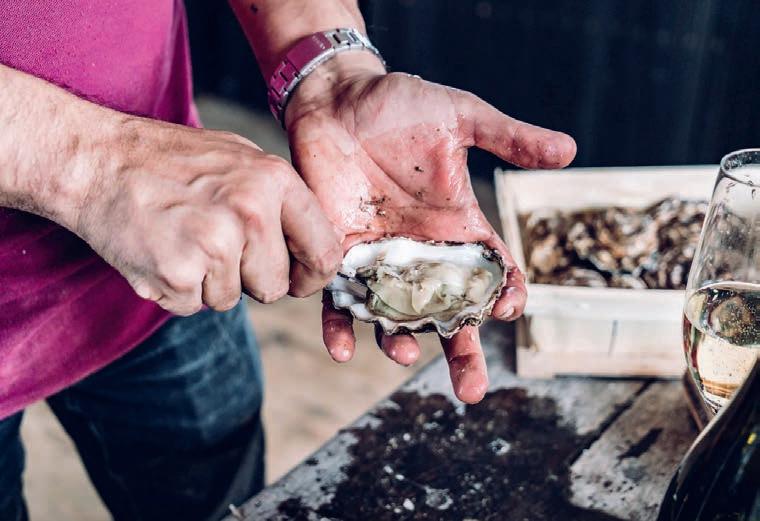
An exceptional oyster, at the heart of our
An exceptional oyster, at the heart of our
The ORKA oyster is selected for its survival rate, its shape and its colour, all for the sake of meeting your expectations.
The ORKA oyster is selected for its survival rate, its shape and its colour, all for the sake of meeting your expectations.
Variété : Crassostrea gigas oyster
Variété : Crassostrea gigas oyster


Tailles : G1.5 to G8
Tailles : G1.5 to G8











and seas seriously. We believe that giving the green light to this environmental vandalism for decades to come is not just unconscionable – it’s also unlawful,” the organisation said in a statement.



The SODR Plan requires water companies to deliver a £56bn capital investment plan over 25 years. However, it gives them up to 2035 to improve storm overflows discharging into or near designated bathing waters and to improve 75% of overflows discharging to high-priority nature sites, such as Sites of Special Scientific Interest (SSSIs), Special Areas of Conservation (SACs) and chalk streams. It also gives them until 2050 to improve any remaining storm overflows and put a stop to their industrial-scale sewage dumping.
Crucially for the shellfish community, the plan all but excludes coastal waters from protection, giving farmers little confidence in its ability to make a difference.


In February 2023, the UK government issued a press release stating that Environment Secretary Thérèse Coffey had demanded that water companies share their plans to improve Britain’s water infrastructure.
Under scrutiny from pressure groups, the Environment Secretary asked for a clear assessment and action plan on every storm overflow from every water and sewerage company in England, prioritising those that are spilling more than a certain number of times a year, and those spilling into bathing waters and high-priority nature sites.
She also stated that when water companies don’t follow the rules, they will face higher penalties that are quicker and easier to enforce, so that polluters are made to pay as soon as damage is caused to our rivers and seas.
Currently, water companies caught illegally polluting the water face enforcement action from the Environment Agency, ranging from enforcement undertakings, in which they are compelled to pay to restore any damage to the environment, right through to prosecution in the courts.
The current upper limit on fines is £250m, but a public consultation is to be held soon to find an upper limit that is a real and serious deterrent. In 2021, more than £102m in fines was handed out, and from 2022, the revenue from such fines is being reinvested into schemes to benefit the environment.
“People are concerned about the impacts of sewage entering our rivers and seas, and I am crystal clear that this is totally unacceptable,” Thérèse Coffey said. “We need to be clear that this is not a new problem. Storm overflows have existed for over a century. But through the largest infrastructure programme in water company history, we will tackle the problem at source.”







Acontroversial plan by the Scottish government to ban fish farming and fishing in 10% of Scotland’s waters by 2026 is back on the table after Humza Yousaf’s election as Scotland’s First Minister.

A consultation on the new generation of marine nature reserves to rewild the sea has sparked debate in communities from Shetland down Scotland’s coasts and into the heart of Holyrood and the SNP leadership campaign.
The existing Marine Protected Areas (MPAs) cover almost a quarter of UK waters and have diverse conservation goals. A new designation of Highly Protected Marine Areas (HPMAs) will impose a higher level of protection and further restrictions.
The UK government is creating three HPMAs around the English coast this year. A spokesperson explained: “HPMAs will enable nature to fully recover by removing all harmful activities including fishing, construction and dredging, increasing marine biodiversity,and supporting climate-resilient ecosystems to thrive.”
The Department for Environment, Food and Rural Affairs (DEFRA) agreed to trial the HPMAs – which so far cover just 0.53% of English waters – to test their effectiveness as a conservation measure, and to gauge their social and economic impacts.
Environment Secretary Thérèse Coffey said: “Their introduction follows recommendations in the Benyon Review [commissioned

















 By Sandy Neil
By Sandy Neil


by DEFRA and published in 2019] to help achieve clean, healthy, safe, productive and biologically diverse ocean and seas, and drives forward the government’s commitment to protect at least 30% of the global ocean by 2030.”
Five sites were originally proposed but two, Lindisfarne and Inner Silver Pit South, were dropped after concerns over socioeconomic impacts, including the cost to fishers. The three inshore and offshore sites, which will be designated before 6 July 2023, are Allonby Bay (Irish Sea), Dolphin Head (Eastern Channel) and North East of Farnes Deep (Northern North Sea). Additional sites will now be explored and any future options will also be subject to consultation.
Conservationists welcomed England’s first HPMAs as “crucially important” for the recovery of the seas, but described the whittling down as “nonsensical” and “disappointing”. The proposed site at Lindisfarne was dropped after public opposition and protests by a local vicar that a fishing ban would “rip the heart” out of the community. A proposed site at Inner Silver Pit South would not be designated as the cost to fishers would be disproportionate, the government said. Professor Callum Roberts, a marine conservationist at the University of Exeter, said: “It’s taken three years and eight months to get here from the Benyon report recommendation. At this rate, we’ll get to 30% effective protection in 260 years. That isn’t a timescale that inspires confidence, nor is it a sensible time over
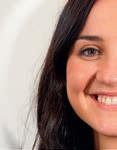
which to build ecosystem resilience to climate change. Seabed carbon stores are at risk as well as wildlife while we drag our feet.”
Dr Lissa Batey, Head of Marine Conservation at the Wildlife Trusts, said scaling back the HPMA pilot from five to just three was “nonsensical” when the seas were in crisis. “HPMAs can provide the essential protection our seas need, and so, while I’m hugely disappointed by the paltry number of chosen sites, I will be celebrating these first three”.
In Scotland, the plans go much further. The Bute House Agreement, a cooperation agreement between the minority SNP Scottish government and the Scottish Green party over this five-year parliament, states: “[We will] add to the existing MPA network by designating a world-leading suite of HPMAs covering at least 10% of our seas ... which will provide protection from all extractive, destructive or depositional activities including all fisheries, aquaculture and other infrastructure developments, while allowing other activities, such as tourism or recreational water activities, at non-damaging levels (making them equivalent to ‘marine parks’).”
Mairi McAllan, who was Minister for Environment and Land Reform prior to her promotion to Cabinet Secretary for Net Zero and Just Transition, has been conducting a consultation, due to close on April 17, with a view to designating HPMAs in 2025.
Fish Farmer asked her what impact the proposed HPMAs might have on aquaculture and if farms found themselves in a newly designated HPMA, would the licence holders be compensated for having to remove the farm?
The response was: “Scotland’s MPAs cover 37% of our sea area, exceeding the proposed global target of 30% coverage by 2030.
“Designation of HPMAs covering at least 10% of Scotland’s seas by 2026 will help us improve marine protection and, as set out in our draft Policy Framework, which is currently out for consultation, it is intended that aquaculture will not be allowed within these areas to ensure high levels of protection from human activity. This includes existing and new aquaculture sites.

Opposite from top: Fish farm, Loch Harport, Isle of Skye; Mairi McAllan; Thérèse Coffey
Below: East Loch Tarbert, Argyll and Bute
“We will continue to work closely with industry to make the transition as smooth as possible and will be considering any adverse consequences as part of the current consultation. Any HPMA policy announcements will include early engagement with industry to support preparedness.”
”So compensation has not been ruled out, but it has certainly not been specified in the consultation.







Meanwhile, communities began to react. In a Shetland News column publicising the consultation in February, the Green MSP for the Highlands and Islands, Ariane Burgess, argued: “While dynamic movements of seas make the conditions in Shetland different from mainland Scotland, it is incumbent on us to see Scotland’s seas as a whole. What happens to the habitats in the inshore waters anywhere in Scotland can have an impact on Shetland’s fisheries.
“The life in our seas and on our coasts has either gone or is in rapid decline. Simply put, in the face of rising sea temperature due to climate change and destructive methods of inshore fishing that damage the seabed and destroy habitats, nature doesn’t have the capacity to recover.
“The way we manage our inshore waters around Scotland is vital to ensuring all forms of life. What future do we want for our last great commons?
“More people need to engage in the issues taking place in the inshore. If we act now, together we can reverse the decline.”
At this rate, we’ll get to 30% effective protection in 260 years
And engage they did. The Executive Director of the Shetland Fishermen’s Association, Daniel Lawson, said: “Shetland’s inshore waters still teem with the same fish and shellfish stocks that have helped sustain our community for generations. We must question where, or who, her information and opinions come from. How can she think to right such wrongs without first speaking to fishing crews?”
Shetland Islands councillor Duncan Anderson added: “The sea does support Shetland, historically, presently and for the foreseeable future. Be it our thriving aquaculture sector, our large fishing fleet, offshore oil and gas, wildlife tourism, cruise ship visits or the much heralded (by the Greens ironically) offshore renewable projects soon to consume our seabed, the marine environment is what keeps Shetland viable.
“Many within Shetland (myself and the Shetland Islands Council included) have been trying in vain for years to get the Scottish government and authorities interested in the rampant pollution, unmonitored landings and flagrant rule breaking of foreign-owned fishing vessels within our waters. Surely this is more worthy of government attention and resources than trying to force unnecessary, socioeconomically devastating, ill-conceived HPMAs on an area such as Shetland that does not want or need them.”
Burgess responded: “Sadly, there is substantial evidence for the decline in marine life in Shetland and elsewhere in Scotland. At some point we have to see the biggest picture – that we are facing climate change and rapid species extinction, which, if we don’t do something about it, will mean there is not much left for future generations in Shetland, Scotland or anywhere on the planet.”
Then in March came a warning from the Scottish Fishermen’s Federation (SFF) that banning fishing in a tenth of Scottish waters “…will have a catastrophic impact on the industry”.
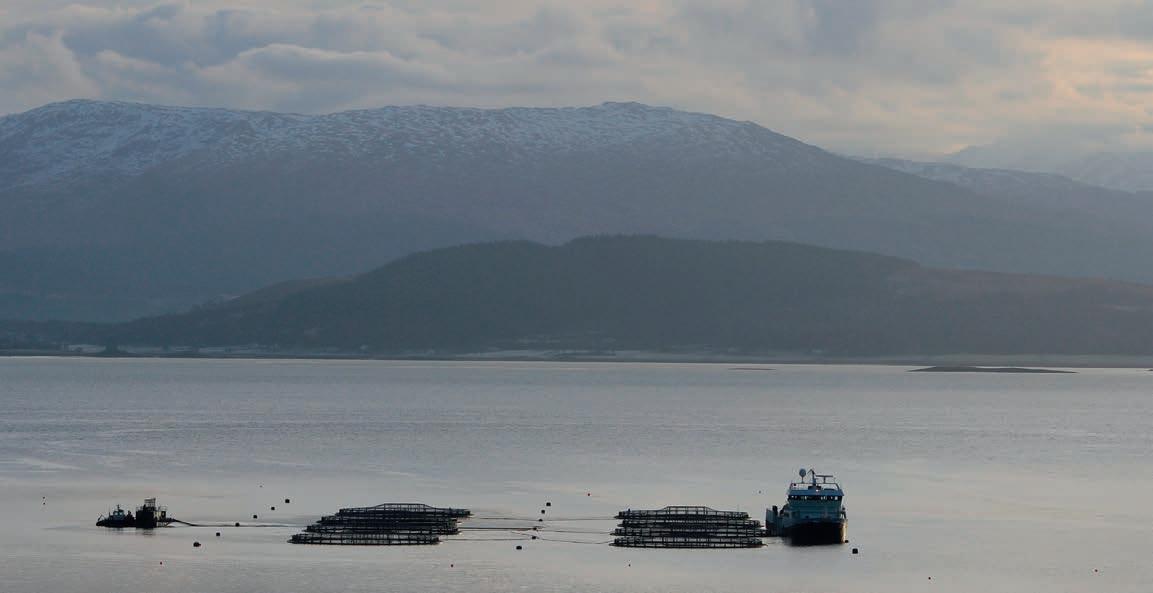
“The strict conservation zones were far too big a price for fishermen to pay when they lacked ecological justification and were being introduced for purely political reasons,” the SFF said in its submission. “In addition, the government’s timeframe of

having HPMAs operating by 2026 is wholly unrealistic for defining or establishing baselines.”



















SFF Chief Executive Elspeth Macdonald added: “On top of the existing spatial squeeze caused by the dash to build huge offshore wind farms with little consideration for their impact on fisheries, the government wants to close a further 10% of our waters to fishing vessels – with no evidence whatsoever that doing so will achieve ministers’ vague conservation aims, nor any attempt to understand the effect of displacing the fishing fleet.


“The underlying assumptions are that fishing is damaging to the environment and stocks are degraded. Neither is justifiable, and in fact the government’s own indicators show that sustainability of commercially fished stocks is on a continuing upwards trend.
“The SFF is urging the Scottish government to have a radical rethink on this, and at very least accept our alternative proposal for two pilot projects to assess the need, practicalities and costs/benefits in a proper scientific manner.”
Comparing with England’s three HPMA pilots, which cover “just 0.53% of English waters”, she said: “What is proposed in Scotland are permanent designations of at least 10% of our seas, to a completely unrealistic timescale and with no proper foundations for their purpose. This is not how to make good policy, and we call on

We will continue to work closely with industry to make the transition as smooth as possible
[the] Scottish government to pause, reflect and rethink.”

Seafood Scotland, the national trade and marketing body for the Scottish seafood industry, backed calls for the Scottish government to reconsider its approach to HPMAs. CEO Donna Fordyce said: “We agree with the principle of protecting marine areas but suggest that this latest announcement has not been sufficiently thought through and fails to take account of the impact on fishers who are already struggling to make a living. We support the idea for creating pilot areas as a first step to allow industry and government to work together, learn how best to introduce protections and, crucially, gather data for meaningful analysis.”

The sudden resignation of Nicola Sturgeon as First Minister, and pledges by the two front-runners to succeed her, Humza Yousaf, the SNP MSP for Glasgow Pollock, and Kate Forbes, the SNP MSP for Skye, Lochaber and Badenoch, threw the plans into doubt.
In the Scottish Parliament on 21 March, Rachael Hamilton, Scottish Conservative MSP for Ettrick, Roxburgh and Berwickshire, asked the Minister for Environment and Land Reform, Mairi McAllan: “Scotland’s Finance Secretary [Kate Forbes] echoed the words of Elspeth Macdonald from the SFF, who has said that the proposals are unevidenced and ‘have been hijacked by the Greens and will push the fishing industry into the red’. The Scottish National Party Health Secretary [Humza Yousaf] has different views and believes that the Greens are right. Which of the two leading candidates to become Scotland’s First Minister does the Environment Minister agree with: the candidate who quotes industry experts or the candidate who panders to Green party ideology?”
McAllan said: “My position is exceptionally clear: we are in the teeth of a climate and nature crisis and the window within which we can take action commensurate with that challenge is narrowing. We must be bold, and the introduction of HPMAs is a bold proposal. By the same token, I am equally clear that everyone who will be affected by the policy will be deeply and widely consulted as we develop that policy... fishing communities should be reassured that their views will be heard as part of that consultation, and the socioeconomic factors that affect the resilience of marine industries, fishers and coastal communities will be taken into account.”
Hamilton quoted the Chairwoman of Tiree Community Development Trust, who said that the island was “perilously close to being non-viable”.
A local fisherman, the MSP added, had said: “If this ... is landed on top of us, we would be wiped out overnight with one stroke of the pen on a chart.”


Kenneth Gibson, the SNP MSP for Cunninghame North, put a counter-argument: “The evidence, not least from the no-take zone in Lamlash Bay, is clear. Protected areas benefit both fishers and fish, and one hectare of protected ocean in which fishing is not permitted produces at least five times the quantity of fish that is produced by an equivalent unprotected hectare. Those fish can then swim into unprotected areas to be caught.”
Rhoda Grant, Labour MSP for the Highlands and Islands, said: “Banning sustainable fishing and marine activity that has safeguarded our waters and their future for generations is nonsensical.

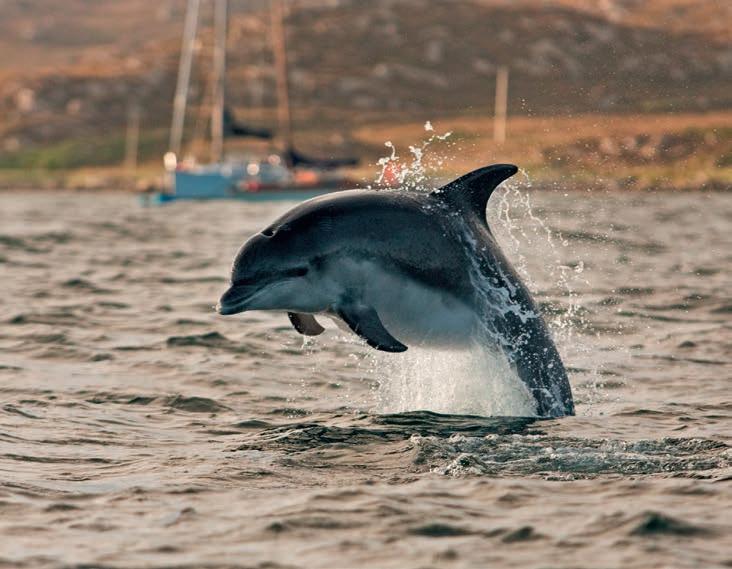

“Harris Development Ltd summed up the views of many island communities when it said: ‘It is sheer arrogance for desk bound “experts” to suggest that we are not looking after our environment and protecting our stocks. The whole basis of the HPMA is that locals are clearly not doing what they should and need to be told how to look after it. You take no cognisance of the evidence that is available of sustainable fisheries and local, voluntary measures put in place before marching in [and] wiping out our communities.’”
 Opposite from top: Salmon farm, west coast of Scotland; Elspeth Macdonald; Kate Forbes This page from top: Bo�lenose dolphin, Isle of Coll; Velvet crab; Rachael Hamilton
Opposite from top: Salmon farm, west coast of Scotland; Elspeth Macdonald; Kate Forbes This page from top: Bo�lenose dolphin, Isle of Coll; Velvet crab; Rachael Hamilton
Grant added: “Will the minister listen to our communities and support their work in protecting their marine environment rather than taking a top-down approach?”

McAllan replied: “There is no part of this that I do not want the views of stakeholders to be embedded within. On the reason why we have to do this, I mentioned the IPCC, which has been absolutely clear that there is a narrowing window. Equally, the Scottish marine assessment tells us that we have much more to do to achieve good environmental status and to protect ecosystems and habitats, including from damage by fishing. All of that underpins the policy.”
Beatrice Wishart, Liberal Democrat MSP for the Shetland Islands, also said: “The 10% figure for HPMAs in the Bute House agreement seems concocted. Will the minister explain the scientific basis for the figure and consider evidence-gathering pilot projects?”
McAllan replied: “The European Union biodiversity strategy for 2030 requires member states to step up their conservation efforts to protect 30% of Europe’s land and sea by 2030, of which 10% will have to be strictly protected. Therefore, Scotland is not out of step.”
The new First Minister inherits a full in-tray and within the pile is a plea from Orkney’s seafood sector, which says HPMAs “could threaten the future of critical coastal businesses and the communities they support”.
Fishermen, fish farmers and companies in the extended supply chain warned that the introduction of HPMAs would destroy aquaculture and commercial fishing activities, which are “cornerstones of the Orkney economy”.

Orkney seafood representatives said a lack of baseline data, combined with an absence of defined tools and methodologies to measure the success of the HPMAs, undermines the ability of the policy to achieve its environmental objectives.
There are fears that the government’s 2026 deadline will see HPMAs rushed through without proper scrutiny of how they will work in practice, or an understanding of the significant socioeconomic impacts resulting from the proposed restrictions. Fishing and aquaculture in Orkney directly employ more than
390 people, as well as the hundreds of supply-chain jobs in more than 30 enterprises.
Hannah Fennel, Head of Orkney Fisheries Association, said: “The introduction of HPMAs acts as an existential threat to marine industries and jeopardises both their future and the communities that rely on them. Sustainability and stewardship are at the heart of Orkney’s fishing and aquaculture sectors, and we are committed to help secure healthy seas and ecosystems around Scotland.
“However, we do not believe HPMAs are the solution. Instead, we need a conservation tool that is grounded in science, not on assumptions and ideology, and takes a constructive and rigorous approach to marine management, and that does not adversely impact island communities.’
Scottish Sea Farms’ Head of Sustainability,




Anne Anderson, said: “One aim of HPMAs is to enhance the benefits that coastal communities and others derive from our seas. But the ban on aquaculture and fishing in these areas is absolutely contradictory to achieving this aim, given their importance as sources of employment and investment in these communities.
“Furthermore, the proposals insist that impacts will not be disproportionately focused on some sectors. But while existing developments for marine renewables, ports, harbours, marinas, cables and pipelines, as well as oil extraction, are allowed to remain, because they are either defined as being of national importance or cannot be relocated, recoverable sectors such as aquaculture and fishing activity are excluded.”
Opposition to HPMAs has also come from the Communities Inshore Fisheries Alliance, which represents creel fishermen, mobile fishermen, line fishermen, dive fishermen and other small family businesses, from Orkney, to the Western Isles, to the Clyde.

Shetland Island Council, meanwhile, unanimously supported a motion instructing its officers to oppose HPMAs in the “strongest possible terms”. Western Isles councillors, too, said the proposals would be “devastating” for the local economy. The Comhairle nan Eilean Siar (Western Isles Council) concluded: “On a positive note, windsurfing, swimming and snorkelling will be allowed within HPMAs at carefully managed levels.”

On the campaign trail, the two leading candidates to be SNP leader and Scotland’s First Minister took opposing views. Yousaf told Shetland News on 23 March: “Highly Protected Marine Areas is at a really early stage. We’re at consultation stage – we’ve not got the criteria let alone the site selection.
“So what I would certainly do as First Minister is make sure that whichever minister is leading that, and the government as a whole, really take into account the views of our fishing, coastal and island communities.
“We’re not going to impose Highly Protected Marine Areas on a community without engaging with them and consulting with them.”
But his main rival, Kate Forbes, said she would scrap the plans and instead commission a feasibility study into devolving marine powers to local authorities, if elected First Minister. Forbes said regulations shaped by coastal communities would better reflect local needs and values, while also protecting the marine ecosystem for future generations.
She said: “As I understand it, no other EU country has implemented HPMAs and there is no evidence to demonstrate that they actually achieve their aims. The current
plans will have a disproportionate socioeconomic impact on our island and coastal communities, and could impact work being done in other parts of government to reverse population decline. There is concern from all corners of the fishing and processing sector, with potential implications reaching beyond fishing into small-scale and community-led renewables, harbour infrastructure and marine tourism to name a few.
“I cannot understand why anyone, particularly when we are deliberately trying to stem depopulation in rural areas, thought it would be a good idea to take such a blanket approach. Our food and drink sector is a success story. Our exports reached record high levels in 2022, but these proposals would decimate the seafood industry.
“Across government, we have to look at cumulative impact, rather than work in a silo. This current consultation illustrates the perils of poor engagement with communities and the rural economy. It’s an example of how not to do government.”
Tavish Scott, Chief Executive of Salmon Scotland, wrote to all three First Ministerial candidates to seek continued support for the sector, and to raise concerns about proposed ban on marine activity.

He wrote: “I wish to express our strong desire to continue the positive relationship we have with the Scottish government” and praised Rural Affairs Secretary Mairi Gougeon (who retains her post) for being a “tireless champion for Scottish salmon”.
He added, however: “We ask that government thoroughly consider the social and economic impacts of this policy [HPMAs] on the sectors, industries and communities that operate in Scotland’s coastal regions, as well as those that are impacted across Scotland through the supply chain.
“That is yet to happen and if government does proceed with this policy, a thorough understanding of the impact on business, livelihoods and communities is essential.”
After a vote of party members, Yousaf succeeded Nicola Sturgeon as SNP leader and Scotland’s First Minister. After the other candidate, Ash Regan, was eliminated in the first round, Yousaf defeated Forbes by 52% to 48% in the second round.
Within hours on 27 March, the Scottish Greens Party Council unanimously voted to support Yousaf in becoming First Minister and to continue with the Bute House Agreement.
Scott said: “We congratulate Humza and look forward to working with him to promote the global success story of Scottish salmon and deliver further sustainable growth. Our members want to see a more streamlined licensing system for aquaculture, action to tackle the rural housing crisis, and a commitment that proposals for HPMAs are based on evidence, not ideology, with a thorough understanding of the impact on business, livelihoods and communities.”
Balancing the demands of fishers and fish farmers with those of the environmentalists will be just one of the tricky issues Yousaf will now have to address.
We do not believe HPMAs are the solution… we need a conservation tool that is grounded in science
Cod farming in Norway is starting to come under the cosh from a diverse group of opponents, ranging from smaller left-wing political groups to leading conservation organisations.

It is a branch of aquaculture that has largely been left alone by protesters as salmon farmers attract most of the attention.
But since reports last year of a mass escape from a farm owned by Gadus (now renamed Ode), questions are being asked about whether the industry is fit for purpose. In that incident, 87,000 fish are thought to have escaped.
More recently, Norcod was forced to slaughter the contents of at least two cages after it was discovered they had become sexually mature, developing into spawning fish ahead of expectations.


Calls are growing for a tightening of regulations, with some suggesting cod farming should be outlawed altogether.

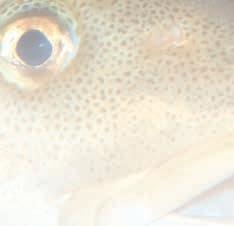



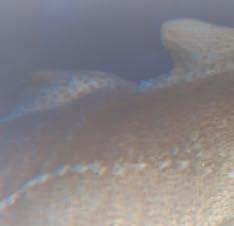
That is certainly not the view of the Norwegian government. The employer organisation Seafood Norway met Fisheries Minister Bjørnar Skjæran recently to seek reassurances and to stress the increasing


importance of the sector.
The delegation came away generally satisfied that the minister is keen to support the development of Norwegian cod farming.
Rune Eriksen, Seafood Norway’s steering group leader and Chief Operating Officer with cod farmer Vesterålen Havbruk, says the sector has become an important value-creating industry, adding that patience is needed.

The cultivation of what is still the most popular white fish species (particularly for consumers in Britain) is not new.


Norway tried it in the early 1980s, but it failed to get off the ground due to various breeding challenges.
The biology has improved immensely since then, thanks to various research and











It is time for the farming industry to show itself to be more responsible
around spawning in cages.
Several companies have now built cod farms and are starting to strike sales deals with buyers at home and overseas.
Cod farming does involve heavy investment, which is why the sector has yet to make a meaningful profit, but it is on the way there.
Wild cod stock remain under pressure with strict quota controls in the Atlantic and Barents Sea, so catch rates are unlikely to increase any time soon.
No one is remotely suggesting farming will replace conventional cod fishing, but, given enough time, it could help maintain supply.
In the past year, cod prices have climbed with salmon at the same dramatic rate, making investment in farming economically viable.
Not everyone is in agreement, however. Norway’s small but influential Green Party says the sector’s expansion should be slowed down while the SV or Socialist Left Party fears a potential national disaster if growth is allowed to continue.
Green spokesperson Rasmus Hansson says the number of escapes is becoming “alarming” and has urged the Fisheries Minister to halt further development until the industry can better control what happens at its sites.
BOTH sides of the cod debate were echoed recently on the regional website (North Norway) Nordnorskdebatt.no

Dag Johansen, board member of the Nordland Nature Conservation Association and Hans Erik Busch, Head of the Lofoten Nature Conservation Association, said: “We are very concerned that such an investment [in cod farming] could cause lasting damage to the local cod population and the skrei [a special type of Norwegian migrating cod].”
Hansson says cod are able to gnaw through the cages and he is concerned that when they get out they will mate with wild fish, leading to increased infection and parasite problems along the coast.
“It is time for the farming industry to show itself to be more responsible and less greedy,” he says. “The coast cannot tolerate escaped farmed cod threatening coastal cod alongside farmed salmon threatening wild salmon and trout.”
“Fisheries Minister Skjæran must stop cod farming until the industry has control over its fish. The coastal environment cannot withstand even more stress from the aquaculture industry,” he told financial journal E24.no

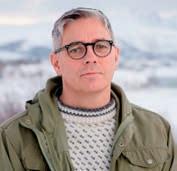

The SV party spokesman, Torgeir Knag Fylkesnes, has weighed in with similar concerns.







“The recent escapes show that cod farming is not under control. The effect it can have on wild cod is enormous – a potential national disaster for a very important industry and cultural heritage,” he says.
The Conservative (Høyre) Party, which may well lead the next Norwegian government, takes a more positive view.
The party’s industry spokesperson Lene Westgaard-Halle sees no reason to stop cod investment now.
“I think the potential in cod farming is very large. Together with the industry, we can develop this into a new fishing adventure in line with salmon,” she told E.24.
Specifically, her party is calling for investment to improve expertise and for additional coastal sites to be made available.
“It needs to be done (in a way) so that the municipalities don’t say ‘no’ simply because they don’t know what it is involved, thus missing out on many jobs,” she says.





Westgaard-Halle is impatient to get the industry properly up and running, pointing out that companies are finding it difficult to gain access to new locations.

They argued that the industry has been unable to document its claims that cod would be unable to escape or to spawn in cages at sea. These problems had been known in the earlier phase of cod farming, they said, and they remain unsolved. Johansen and Busch added: “The Nature Conservation Association refers to several large escapes of farmed cod from recently established farms in Møre and Romsdal and Nordland regions.
“Local fishermen are finding large numbers of deformed cod. This fish has behaviour and body shape that is obviously not natural.
“In addition, greatly enlarged livers and different stomach contents than in wild cod have been observed. The same fish is reported as partially ready to spawn.”
The biggest problem is that the cod spawns in a marine environment,and therefore it is difficult to avoid the cod spawning in the cages. When fish spawn in open cages eggs or larvae will be transported by the current over large distances, leading to the mixing of both types of cod.
Krister Hoaas, Head of Cod Farming, Seafood Norway, argued in reply: “Cod farming can, if it is allowed to grow, create safe, year-round district jobs through the production of healthy food, with low land requirements, low environmental footprint and low climate emissions… today’s farmed cod has been developed over two decades and all the experience so far indicates that there is less risk of escape than was the case in the past.” He added that one escape incident is one too many, and cod farmers are working with the escape security committee (Rømmingsikringsutvalget) at Seafood Norway to share knowledge and experience with salmon and trout farmers. As regards the spawning problem, Hoaas said that knowledge had improved over the past 10–15 years, and the problem has been reduced through breeding, light management and other measures. The industry, he said, was working with research organisation Møreforskning, the Norwegian Institute of Marine Research, Nofima, various universities and the Research Council of Norway. “Results from the research must of course set the stage for how the industry is developed further,” he concluded.

West Africans are facing competition for the fish they used to eat, but who’s to blame?
By Dr Martin Jaffa
Feedback Global (which has added “Global” to its name since I last wrote about it) campaign against salmon farming, claiming that demand for fishmeal is depleting wild fish stocks, especially around Africa, causing great harm to local communities that depend on fish for food. It argues that if salmon farmers were to stop using fishmeal, the fish would be left in the sea to benefit local fishers and the people of the region. Unfortunately, Feedback Global fails to understand the international trade in fishmeal. If salmon farmers removed all the fishmeal from their feed, then it would simply find another market, probably pig or poultry. In the past, fishmeal was used in the feed for these animals, but as demand from aquaculture increased, the fishmeal became too expensive for them to use. If salmon farmers stopped using fishmeal, overall demand would fall and prices would drop, making it more economically viable for greater inclusion in terrestrial animal feeds. Feedback says it is better if consumers ate the fish species used for fishmeal directly rather than using it for fish feed. I have previously argued that rather than attack users of fishmeal, Feedback should be encouraging fish consumers to eat these species. Certainly, increasing demand for these fish would push up prices, making direct consumption a more profitable option for fishers. Unfortunately, Feedback prefers to attack the industry and has
Above right: Fish market, Senegal

Below: Pet cats consume an estimated three million tonnes of wild fish annually
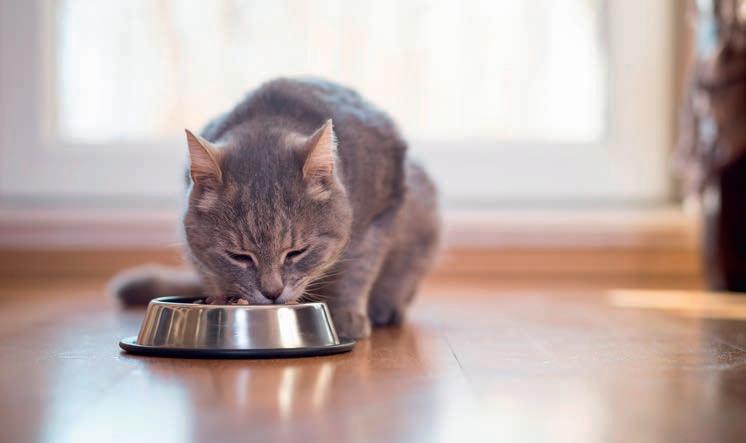
expanded its claims to include all the usual complaints made about salmon farming. This is because in the UK at least, persuading consumers to eat forage type fish would be an almost impossible task. Fish suppliers have enough difficulty getting British consumers to eat anything other than the “big five” species. Even better-known species such as whiting, coley and pollock are not popular.
In March, Feedback Global held an online meeting titled “Feed or Food? Connecting communities impacted by the global fish farming industry”. They invited women from Mauritania, The Gambia, Senegal and Scotland to speak. It was the two from Scotland who were most critical of the salmon farming industry, while the others tended to focus on local issues. The connections weren’t so good, so it is likely that those listening in, including those from Feedback, missed some of the detail. It was necessary to really concentrate to hear the woman from the Gambia mention the word “Chinese” in her speech.
While organisations such as Feedback
Global claim that salmon farming in Europe is harming local communities in Africa, they ignore the reality of Chinese influence.
According to BBC Futures, China is now the largest financier of infrastructure development in Africa, especially of roads, railways, pipelines, power plants and port projects. In the case of The Gambia, in 2017, China cancelled £10m of Gambian debt and invested £23.8m in the development of agriculture and fisheries. This included the construction of three fishmeal factories. The resulting product is not sold on the open market, but is shipped back to China as a feed ingredient, mainly for carp and tilapia, species not usually associated with highprotein diets. However, as production of these species is intensified, which is what has happened in China, then overall more feed protein is required. What used to be extensive pond culture has become highly intensive production.
Yet this demand for fishmeal from within China does come at a price to local
communities. The fishmeal factories now take the larger share of the local catch with local female fish processors and sellers, such as the women who featured on the Feedback meeting, losing out. They have traditionally bought the fish from the local fishers, and then smoked it or sold it fresh at local markets, but availability of the fish they buy has fallen due to demand from the fishmeal plants and overfishing.
Yet, despite the problems, not only to local fish supply but also of claims of damage to the environment and to tourism, China has subsequently announced that it will be investing further in Gambian fisheries, but it is unclear to what extent. Obviously, China believes it is reaping the benefits of its relationship with The Gambia and wants it to continue irrespective of the cost to locals.
The fundamental problem in West Africa is China’s policy of influence, which results in an exchange of natural resources for infrastructure. However, campaigning against such policies is probably far beyond the capabilities of a small NGO operating out of London, so instead it has opted to attack the local salmon farming industry for the damage it allegedly causes to local African communities.

As mentioned, the Feedback meeting included talks from two Scottish women, one from Arran and the other from Ullapool. Although both raged against salmon farming, listing all the usual supposed negatives, the overriding impression was simply one of NIMBYism.
Finally, whilst Feedback focuses on the use of fishmeal in farmed fish, it chooses to ignore the use of wild fish in other animal feeds and especially in pet food. The use of wild fish in cat food is estimated to be at least three million tonnes worldwide. It is easier to upset a few salmon farmers than millions of pet owners.
The fundamental problem in West Africa is China’s policy of influence
Insects fed on plastic could be a viable part of the diet for farmed fish, a Glasgow-based study has suggested.
SalmoSim, an in-vitro salmon gut simulator based at the University of Glasgow, has found that waxworms fed on plastic waste are as digestible for farmed salmon as other commercially available insect meals.



Waxworms are the larvae of the greater wax moth (Galleria mellonella). Evolved to eat the detritus inside beehives, including beeswax, the caterpillar larvae can even digest polyethylene, which is inedible for most other organisms. They are able to do this with help from the bacteria in their gut. Waxworms are currently used as feed for pet reptiles, amphibians and birds.
Hopes have already been raised that waxworms could help tackle the global plastic pollution crisis. SalmoSim’s findings go a step further, suggesting that protein sources for farmed fish could be derived from insects that have been used to digest plastic waste, thus contributing to the wider circular economy.
Using insects to substitute for marine ingredients in aquafeed would reduce the pressure on wild fish, and polyethylene is a difficult plastic to recycle. If plastic-fed waxworms could be used to feed farmed fish, this would solve two environmental problems at the same time.
SalmoSim was developed to study the salmon’s gut microbiome. The company, a spin-out from the University of Glasgow, has now developed “SalmoSim Digest”, which predicts the digestibility of alternative ingredients alongside a model for the absorption of nutrients by the fish. Benchmarking of the SalmoSim Digest model against tests on real salmon show that SalmoSim is 87% accurate.
The experiment tested the hypothesis that waxworms fed lowdensity polyethylene (LDPE) could be a more accessible source




of protein for fish feeds.
As part of the testing process, waxworms were maintained with a diet of either LDPE plastic (cling film), unfed or fed a traditional balanced diet, and waxworm growth was monitored. Waxworms fed LDPE gained weight compared to unfed controls.

A waxworm meal powder was produced and subjected to the SalmoSim digestibility assay, with digestive phases mimicking the stomach, pyloric caecum, mid-gut and hind-gut of Atlantic farmed salmon. During enzymatic digestion, small nutrients were absorbed from the digesting feed and the amount of absorbed amino acids were determined by spectrophotometric assay.
In-vitro digestibility was calculated by comparison of crude protein concentrations before and after the digestibility assay in a manner mimicking live salmon feeding trials to determine a digestibility coefficient value for each bioreactor digesting the ingredients.
There

is clearly exciting potential here
No significant difference in absorbed amino acids was found when comparing the control waxworms with those fed LDPE plastic, indicating their plastic diet did not impact on the waxworm’s concentrations of amino acids digestible by salmon. Interestingly, SalmoSim said, the overall digestibility of plastic-fed worms was slightly higher than those fed on normal feed, although in terms of energy and protein content they are less rich than, for example, mealworms or black soldier fly larvae.
Martin Llewellyn, Professor of Molecular Ecology at Glasgow University and Founding Director of SalmoSim, says: “We are hugely encouraged by these data, which indicate waxworms used to break down plastic could be a potential source of protein for farmed Atlantic salmon. As the pressure on wild fish stocks used for fish meal continues to grow, the need to find alternative, sustainable and low-cost feed stocks for farmed fish has never been greater.
“While the next step is to ensure that plastic-fed wax worms pose no toxicity to salmon and can safely enter the human food chain, there is clearly exciting potential here and we look forward to continuing with our research into sustainable protein sources for farmed Atlantic salmon.”



He adds that the SalmoSim approach is ideal for trying out novel feed ingredients








before risking them on live fish: “Because it’s a simulator, you can afford to be bold.”

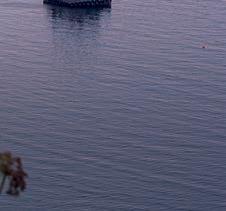


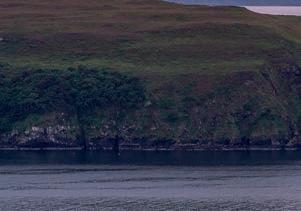

To make waxworm meal a safe feed ingredient, any traces of harmful elements such as microplastics and ethylene glycol – which is essentially antifreeze and a toxic substance for fish – would need to be removed. Llewellyn is confident this would not be difficult, however.

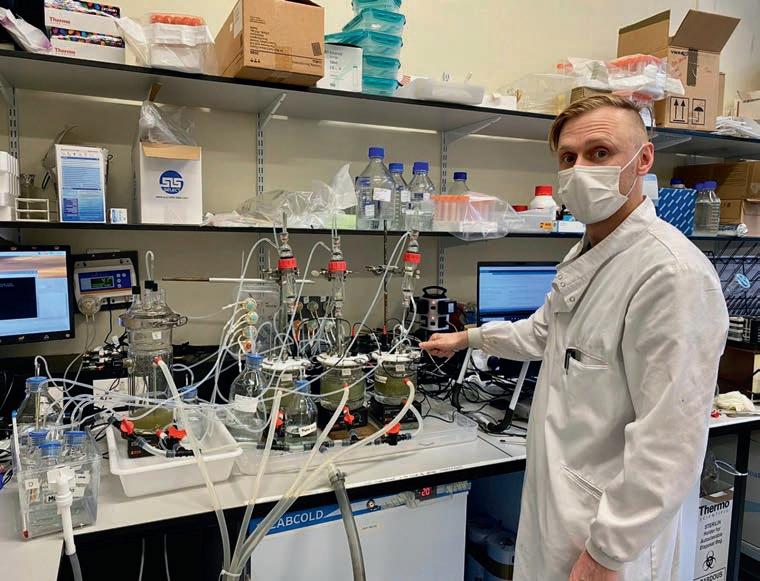
The study suggests that compared to other insect meals, and benchmarked against fish meal, waxworms performed very well and could be an important source of feed for salmon. Further testing is now required, the company said, to establish that salmon reared on a diet that includes plastic-fed waxworms is safe for human consumption.

 Opposite from top: Waxworm; The SalmoSim lab team; The tes�ng process; Waxworm meal
Above: SalmoSim Technical Director Joseph Humble
Opposite from top: Waxworm; The SalmoSim lab team; The tes�ng process; Waxworm meal
Above: SalmoSim Technical Director Joseph Humble


WellFish Diagnostics, the startup animal health company based at the University of the West of Scotland, was delighted to be awarded the prize for best Innovation Showcase (Audience award) at the 8th Animal Health, Nutrition & Technology Innovation conference, which was held in London at the beginning of March. Professor Brian Quinn, CEO at WellFish (pictured, receiving the prize), said that he was “absolutely thrilled that WellFish Diagnostics won this award”. www.wellfishdiagnostics.com
Mowi Scotland’s fish health team has been bolstered by the recruitment of fish health observers (FHOs) from among the staff throughout its farming locations. Their role includes overseeing fish health and welfare, including cleaner fish deployment, welfare monitoring, biosecurity, vaccine auditing and other important activities .

A recent event in Fort William (pictured) brought together FHOs, site managers and assistant managers, a colleague from Norway and Professor Pieter Van West from Aberdeen University. After the meeting, the group visited one of Mowi’s land-based hatchery and smolt units where the FHOs were provided with hands-on training in health monitoring techniques.
The salmonid rickettsial septicaemia (SRS) epidemic has severely affected salmon populations within Chile and Canada’s aquaculture fisheries. By utilising Sightline’s data analytics solution, fish farmers can gather information in minutes and identify critical problems in the salmon’s biomass, such as disease, parasites and general illness. Sightline’s root cause analysis determines the best course of action when facing a problem and identifies issues before they occur. Via machine learning, data is continuously monitored and assessed for anomalies. Catch and prevent serious disease outbreaks like SRS with Sightline EDM’s advanced data analytics software. www.sightline.com
One phrase keeps recurring in the annual reports of the big salmon farmers when referring to the performance of their Scottish operations in 2022: “biological challenges”.

Last year was a tough one for salmon mortalities in the waters around Scotland. As reported in Fish Farmer’s February issue (“Storm over Scottish mortality rates”), around 15 million mortalities were recorded compared with just 8.58 million in 2021 and 5.81 million in 2020.
Problems were not, of course, confined to Scotland: in Norway, recorded mortalities were 58 million, according to the country’s Institute of Marine Research. That was up by a million on the previous year, although the increase can be attributed to an increase in production.
In contrast, the biological challenges Scotland experienced last year have been widely seen as exceptional. The premature losses and treatment costs have hit producers’ profits and, just as importantly, the industry’s reputation.
Anti-fish farming activists were quick to jump on the issue. For example, Animal Equality UK blamed the mortalities on “overcrowding”. Analysis of the statistics month by month, however, shows that there was a spike in mortalities in early autumn, indicating a seasonal factor at play. In September, for example, survival was down
to 95.3% compared with a four-year average of 97.7%.
Fish health is, of course, a complex, multifactorial issue, but the biggest challenge for 2022 appears to have been gill health, together with associated bacterial infections.
Speaking at the Fish Veterinary Society’s Spring Conference in Edinburgh in March, Bakkafrost Scotland’s Biology Director, Dr Dave Cockerill, said: “Gill health remains the biggest challenge and is an ongoing threat to survivability.”
He explained: “‘We [the salmon industry as a whole] started 2022 putting out fires, dealing
We need measurements in strategic locations – these blooms do not come from nowhere
One species of micro jellyfish appears to have been the key factor in the increased level of biological challenges faced by Scotland’s fish farmers last year
with AGD [amoebic gill disease] problems from the previous year.”



The situation stabilised until late summer, he said, but then mortalities spiked, industry wide.







What happened? The evidence points to an increase in zooplankton blooms associated with higher sea temperatures in what was an exceptionally warm summer throughout the British Isles and Ireland.
Also at the FVS conference was Ana Herrero, Senior Fish Health Adviser with fish health specialists PatoGen. She noted that blooms of phytoplankton (algae) and zooplankton each pose threats to farmed fish, with phytoplankton tending to bloom in spring and early summer, and zooplankton following on from to bloom in late summer and early autumn.



Harmful algal blooms (HABs) are associated with ichthyotoxins, mechanical damage, mucus overproduction and oxygen depletion.
As far as zooplankton blooms are concerned, the biggest problems come with species in the phylum Cnidaria, which includes stinging organisms such as jellyfish, hydrozoans, sea gooseberries and sea anemones.

These, Herrero explained, are associated with physical and venomous damage, infections and ambient oxygen depletion, and they can also carry bacteria.


She added: “Larger jellyfish can also clog the nets, restricting oxygen flow.”

For fish farmers, however, the biggest threats come from smaller cnidarian species, also known as micro jellyfish.


Hervé Migaud, Fish Health, Welfare & Biology Director, Mowi Scotland, says that his company’s monitoring programme identified one species above all others as the key factor in last year’s biological issues: Muggiaea atlantica








This micro jellyfish looks and acts like one organism but, like larger jellyfish, it is a colony of organisms living symbiotically. Migaud explains: “This species is not new, but we had not previously seen it as a ‘bloom’ species.”
First identified in the 19th century, numbers of M. atlantica have grown and their range has spread over the past few decades. They grow seasonally, typically with population peaks in May/June and September/November. M. atlantica feed on copepods, including sea lice. When they spread in large numbers the micro jellyfish therefore reduce the number of sea lice, but they also deplete the copepods that graze on phytoplankton, leading to an increase in algal blooms.
M. atlantica are 2mm in length and transparent, so they are hard to spot and they pass easily through salmon nets. They can harm fish when they discharge their stinging cells, causing gill damage and making the fish vulnerable to bacterial infection.
Migaud says: “We first identified them as a problem around August last year. They can appear at high density and they are toxic.

“We saw a lot of PGD [proliferative gill disease] and complex gill disease, and some AGD. It became a perfect storm, and it was hard to treat or even feed the fish.



“You can’t stop them from blooming or even from entering the cages. We have aeration systems, but they weren’t helping in this case.”
There are, however, measures that can be taken to mitigate the threat to stock. As Migaud explains, it is possible to avoid stocking high-risk sites during periods that are likely to see the most intense blooms.





Fish are more vulnerable to damage when they are feeding, so feeding schedules can also be planned around expected risk periods.
The Mowi team has learned a lot from last year’s experiences, Migaud says, but the most important lesson is the need for thorough monitoring.
He stresses that although Mowi was the only company to carry out daily monitoring for zooplankton last year, the plan is to step up monitoring still further for risk periods this year: for every site, every day and at different depths.

Collaboration and data sharing between producers will also be important, he says: “In order to monitor the threat, we need measurements in strategic locations. These blooms do not come from nowhere.”




Dr Iain Berrill, Head of Technical at industry body Salmon Scotland, agrees with Mowi’s conclusions: “The presence of blooms of microscopic jellyfish (M. atlantica) was one of the biggest factors behind reduced survival rates on some of our salmon farms in 2022.
“We have been open and transparent about the challenging survival rates we experienced towards the end of 2022, including the significant contribution micro jellyfish had on the sector. We have also explained the steps salmon farmers are taking to protect their livestock in the current farming year.”
He adds that the industry is in the process of developing an early warning system to help to deal with the challenge of micro jellyfish and other harmful plankton. As reported in this magazine (“Tomorrow’s threats”, Fish Farmer, December 2022), the Sustainable Aquaculture Innovation Centre (SAIC) has already completed projects to help harmonise monitoring protocols across the sector, adapting a system originally created to provide shellfish farmers with an early warning of threats from HABs.
SAIC has secured £250,000 in funding from DEFRA for training specifically on this issue. Berrill says: “Salmon Scotland and our member companies are working with SAIC and other partners to develop this training.
“Early warning and sharing of information, coupled with standardised operating

procedures, will help our farmers to take quicker preventative action to safeguard their fish in the event of future jellyfish blooms and HABs.”
Bakkafrost’s Dave Cockerill also points to other measures his company is taking to improve survivability, including investment in larger wellboats to administer freshwater treatment and the long-term move to a “large smolt” strategy, giving the fish longer time to grow before introducing them to the sea. This way, the fish will spend only one summer in cages at sea, rather than two.
Cockerill stresses, however, that the time to take action is before any physical signs of gill damage are apparent: “Gill pathology is a lag indicator – once gill damage has taken place, it is already too late. Lead indicators include, for example, the AGD amoeba count per swab, blood and heart biomarkers and testing for compromised oxygen delivery. Lactate is also a good biomarker to indicate stress.
“Treatment has to be timely, as late treatment of AGD allows amoebae to ‘dig in’. We now believe that AGD has to be brought to zero by Q2.”
The scale and timing of micro jellyfish
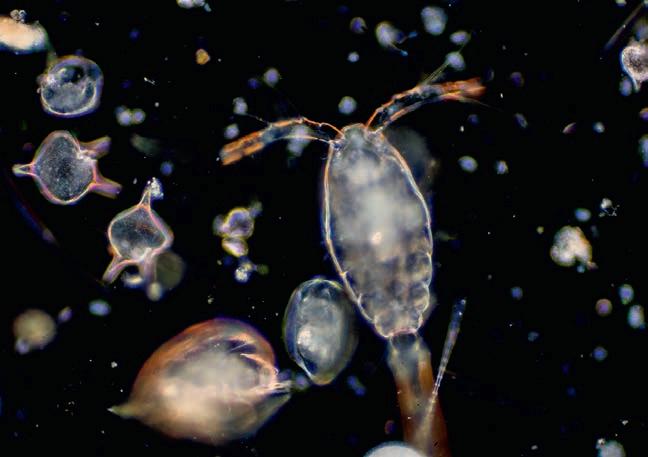


blooms are affected by ocean temperatures and also by salinity, which varies according to rainfall. The long-term forecast for this year is for another warm summer, but Migaud warns that it would be a mistake to expect that this year will inevitably be a repeat of 2022: “We should not focus on just one species; we need to monitor all the zooplankton and phytoplankton. This year, for example, the challenge might be phytoplankton, which we’d need to deal with via aeration.
“Not everything is down to climate change. But it’s hard to imagine that it is going to get better over the next 20 years.”
He is optimistic, however, that the industry’s understanding of biological threats will continue to grow: “We have colleagues around the world, especially in Chile and Canada, who have experienced blooms like this for a long time. We have to learn from each other.”
Meanwhile, Iain Berrill concludes: “We are seeing encouraging signs for 2023, with our January survival stats showing that year-onyear survival was higher than in January 2022. But we will never be complacent and will remain vigilant to the risks posed by HABs and jellyfish blooms.”


• Extra light
• Volumes down to 0.02 mL
• High performance
• Long durability
www.socorex.com
Product information:


Since the company launched 18 months ago, WellFish has been engaging with Scottish and Irish fish health managers to provide advice on stock health through the lens of rapid blood biochemistry assessment – also known as biomarkers.

“But what do they actually tell us?” is a reasonable and common question amongst fish health practitioners who are interested in, but slightly unsure about, how blood biomarkers can contribute to their understanding of the health of fish in their care. Similar caution has accompanied the development of most diagnostic tools on their journey to mainstream acceptance and the reasons are largely the same: “What is normal?” and “Can abnormal be assessed by degree?”
The road to confidence here has many carriageways including validation, consistency and quality of sampling; sufficient sample volumes; and consistency of interpretation etc. Through an assiduous approach to sample quality, laboratory process, and data interpretation, driven by appropriate statistics, WellFish are building
confidence in a method where the output is a value rather than an opinion.
At WellFish we are acutely aware of the need for a solid database of so-called “biomarker endpoints” which can be compared to the variables to which they might be responding. So, if for example, a particular biomarker is elevated in response to very low levels of micro jellyfish, in order to be useful this relationship must be validated through multiple observations. We use mathematical modelling and deep machine learning to mine and strengthen the relationships between the variables that determine endpoint values and the outcomes to which these, in turn, are contextually related. Complex regression analysis measures the statistical inference between biomarker end points and clinical outcomes.
Over the last six years, WellFish has developed a comprehensive biomarker database. As the number of data points grows across different species in different environments, the predictive power of the model is enhanced.
 This page from top: Charles Begley (L) and Amund Litlabø; Opposite from top Dusan Munjin; Miriam Furne
This page from top: Charles Begley (L) and Amund Litlabø; Opposite from top Dusan Munjin; Miriam Furne
The more data we gather from blood biomarkers, the better we understand what they are telling us.
If you measure it, you can manage it
This means that our data scientist, using his AI model, can find important insights into stock health and welfare which now routinely contribute to the decisions, often high value, which must be made in the management of those fish. Examples of this have included alterations to dietary formulation, delay, and/ or sequence alterations to treatment regimens as well as, most seriously, the decision to prematurely harvest populations which are deemed at high risk of non-recovery.
Such decisions are, of course, not taken based upon blood chemistry alone. By monitoring biomarkers, however, health practitioners are deploying a sentinel tool that can provide an early “heads-up” when things are not right and may require further detailed investigation. WellFish use a traffic light system, similar to that deployed in human medicine, where biomarker values in the green zone are regarded as normal, whilst those in the amber zone are less good but OK, and those in the red zone indicate that something is not right. (see Fig 1).
By encouraging the routine assessment of these biomarkers in fish stocks, similar to current practice for gill swabbing and lice counting, WellFish are beginning to establish blood biochemistry as the gateway tool that helps managers to decide whether additional techniques, such as PCR and histology, are required. (see Fig 2).
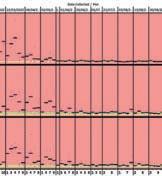
As our understanding of the relationship
between biomarker endpoints and health status improves, it is easy to see the potential for these values to make important contributions to the assessment of fish welfare. Again, when a number replaces an opinion as an indicator, the condition that that indicator seeks to describe can be viewed with greater confidence.
In addition to applications in the production arena, the services of WellFish are also sought by those who operate in R&D that supports this highly innovative industry. Because blood biochemistry is so sensitive in its response to changes in the animal’s internal and external environments, it has become recognized by research groups as a useful quantitative tool for comparing outcomes from trials including those assessing feed additives and raw materials, containment technologies as well as the physiological effects of various treatments.
Going big, focusing on the small!
2023 is a year when things get both big and small for WellFish!
By late spring we will have established a presence in Norway through the installation of a laboratory facility in Bergen. WellFish Diagnostics AS will be directed by our new colleague Amund Litlabø who, along with our other new recruit to the Norwegian operation, Miriam Furne, will set up a team to run the high throughput machines destined for that facility. Later in the year our recently appointed Director for Canada and Chile, Dusan Munjin, will begin the rollout of operations in those two territories. Taking things down to a molecular level is now the responsibility of our new molecular biologist, Dr Charles Begley, who has joined WellFish as a KTP associate to provide a molecular capability to the Company’s diagnostic toolbox to support the clinical biochemistry and confirm pathogen identification.






It is intended that these developments will position WellFish at the vanguard of clinical biochemistry in aquaculture as we promote this science as a new and essential component in the world of integrated, quantitative fish health and welfare management.
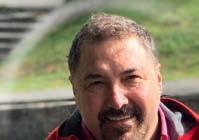





It is easy to see the potential for these values to make important contributions to the assessment of fish welfare
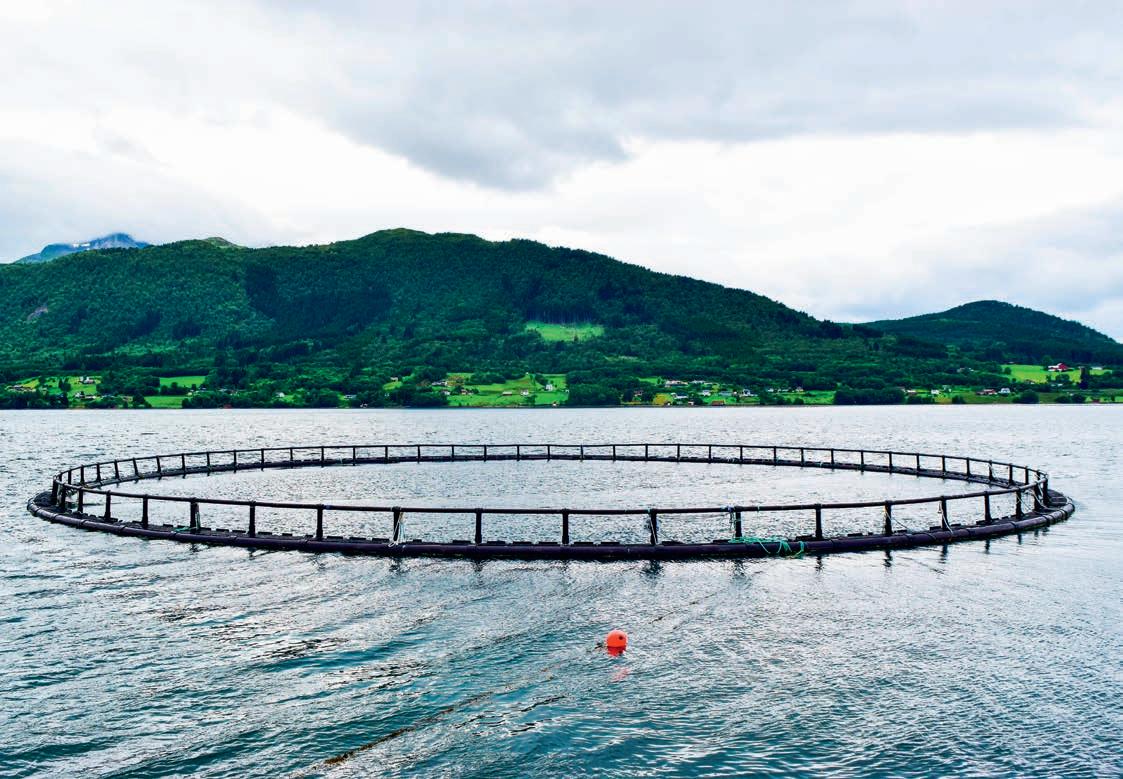 By Vince McDonagh
By Vince McDonagh
The Norwegian Veterinary Institute has published its 2022 annual Fish Health Report – and once again it doesn’t make for comfortable reading for the salmon producers.

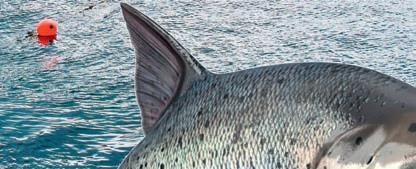

Following February’s Institute of Marine Research investigation, which found that 58 million salmon died prematurely last year (“Multiple threats”, Fish Farmer, March 2023), the Veterinary Institute report says the situation is getting worse rather than better, arguing that far more needs to be done to improve fish welfare.

These latest findings are arguably more important because they embrace a wider range of issues affecting fish health.
Norway’s Fisheries Minister, Bjørnar Skjæran, believes letting another 12 months go by without taking action is no longer an option.

He says: “There are still too many fish getting sick and too many dying. In that respect, 2022 was a worse year than the previous years. We have to do something about this. Fish health must be improved; mortality must be reduced.
“One of the biggest issues in health and welfare concerns how salmon lice controls are carried out.
“But the fact that certain areas and localities have higher mortality than others also means that it is possible to reduce mortality. We will take the results from this year’s report with us when a new animal welfare notice is to be prepared.”
The cost of de-licing
Fish Health Report 2022 shows that a number of




diseases are linked to intensive production and de-licing activities.
Wounds, gill problems and bacterial diseases were among the main contributors to an increasing mortality rate.
Last year, mortality in the sea phase was 16.1% for salmon and 17.1% for rainbow trout, both representing an increase compared with the previous two years. The salmon mortality rate in 2021 was 15.5% and 14.8% for trout.
This meant that, as previously reported, a record 58 million farmed salmon were lost in the sea phase last year.
previously reported, a record
The loss figures in land-based hatchery production are also high. A total of 92.3 million salmon and 5.6 million rainbow trout died in 2022.
Dr Edgar Brun, Department Director for Fish Health and Welfare at the Veterinary Institute, says: “The health and welfare problems that are increasing now can be linked to intensive production and more lice removal. Increased occurrence of gill and bacterial diseases and various wound problems are related to stress, overcrowding and damage to the fish.”
For administrative purposes, Norway’s coastal salmon activity is divided into different production areas and the study shows there are large geographical differences in mortality rates.
It says data from additional sources such as fish health personnel and diagnostic laboratories show there were three main challenges:
• injuries from de-licing operations;
• gill disease; and
• winter sores.
Detected instances of serious viral disease stabilised in the past year, but the increase in bacterial diseases continues.
disease stabilised in the past year, but the





In particular, the extent of winter sores is problematic in terms of animal welfare, but is also given as a reason for the downgrading of fish for slaughter in 2022.
The report’s editor, Ingunn Sommerset, who is also section leader at the Veterinary Institute, says: “There has never been such a high number of locations with winter sores recorded as in 2022.

broodstock has created challenges for deliveries of roe in Norway in 2022.
“In 2022, 98 new pancreatic disease (PD) cases were registered, the number thus being almost identical to the previous year, with 100 cases.
“The last two years both represent a significant reduction from 2020, when there were 158 cases. There were no suspicions or detections of PD virus north of Trøndelag, with the border of the PD-free surveillance zone to the north.”
In the last few years, the fish health study has reported an increase in certain bacterial diseases, a trend that continued last year.
“The disease is no longer just
“The disease is no longer just dominant in northern Norway, but is now found in farmed salmon all along the coast.
“Development of winter sores, especially at low sea temperatures, is negatively affected by demanding de-licing operations, which were also at a record high in 2022.”
But there is some better news on the seemingly never-ending problem of infectious salmon anaemia (ISA).
The report says ISA (called ILA in Norway) was detected at 15 locations last year, which was down on the previous two years.
It adds: “At the end of the year, there were also five unconfirmed suspicions of ILA based on the detection of virulent ILA virus, three of which were at broodstock sites.
“Suspicion or detection of ILA on
“Different types of winter sores are perhaps the biggest the locations in the sea in Western Norway.
“Different types of winter sores are perhaps the biggest health and welfare challenge related to bacterial disease in the Norwegian aquaculture industry, and the diagnosis was made at a total of 433 locations in 2022,” the report adds.




It also found that the ongoing pasteurellosis epidemic in Western Norway, which worsened markedly between 2018 and 2020, with a slight decrease in 2021, is now back up to the 2020 level. Pasteurella infection was detected at 52 salmon locations in the sea in Western Norway. This is a disease primarily occurring in large salmon causing, among other things, boils in the skin, muscles and internal organs.
There are a few positives in the report, which reveals a record number of drug-free treatments against lice took place last year.
“For the country as a whole, the amount of lice per farmed salmon in 2022 was roughly the same as in 2021.
The number of reported drug-free lice treatments increased by 11% from 2021 to 2022.
There has also been a slight increase in the number of drug prescriptions against lice in 2022, although it is far from the levels seen before 2016.
There are still too many fish getting sick and too many dying





Anew high-pressure water jet pump for aquaculture net cleaning — the NLB AQ3250 — introduces several new features that enhance performance and reliability, with more resistance than ever to saltwater corrosion. It provides users with a flow of 400 lpm (106 gpm) at 207 bar (3,000 psi).
In aquaculture, pumps play a key role in controlling the buildup of marine organisms and algae, maintaining good water flow as well as a healthy environment for fish. Heavy buildup weighs down the nets and makes them less effective at keeping fish in and predators out. Keeping nets clean is therefore a full-time job for these pumps (often 12 hours a day, seven days a week), and users cannot afford breakdowns.
NLB pumps have set the standard for reliability for over 50 years, with a slow-running design that minimises wear on key components. When operating conditions expose them to saltwater, corrosion becomes a major concern. The NLB pumps used in aquaculture applications — the Series 205, 305, 405, and 505 — have always had stainless-steel or galvanized components and a removable aluminium enclosure to shield the pump from the sea air. Each of these units provides trouble-free performance with minimal maintenance and comes mounted on a galvanised steel skid. While the new NLB AQ3250 has all these features, it takes corrosion resistance to a new level.

Several innovations set the AQ3250 apart, beginning with plungers made of ceramic instead of stainless steel. Since ceramic’s chemical bonds are already oxidized, further oxidation — and, more


importantly, the corrosion it causes — is very rare. The hardness of this ceramic is another advantage. Its six-micron finish significantly reduces plunger wear, maintaining smoothness and extending the life of the packing.
These ceramic plungers have been shown to perform just like those made of stainless steel, and require less frequent maintenance. They are water-cooled in sealed packing cartridges to keep water out of the plunger well and reduce salt build-up on the subshafts. This means less scraping of the oil seals, which in turn keeps oil from seeping out.
NLB further simplifies (and speeds up) maintenance with a handy kit containing all the parts needed to rebuild the pump’s fluid cylinder. While every pump user knows that a fluid cylinder needs rebuilding after many hours of use, with this kit on board the job can be done without returning to port.
Other new features of the AQ3250 pump contribute to reliable performance. A discharge accumulator buffers the pressure of the high-pressure water, assuring a smooth flow through the hose to the cleaning head.
 Above: Maintenance kits minimise down�me Opposite from top: NLB’s UK branch has expanded and relocated to Darlington; Highperforming ceramic plungers
Above: Maintenance kits minimise down�me Opposite from top: NLB’s UK branch has expanded and relocated to Darlington; Highperforming ceramic plungers
A suction stabiliser at the suction manifold port keeps a steady supply of water available to the pump.

The footprint of the AQ3250 is fairly modest (2,565 mm/8.4 ft x 1,525 mm/5 ft × 1,730 mm/5.7 ft — 2,015 mm/6.6 ft) to the top of the exhaust) and its weight (3,000 kg/6,614 lbs)) minimises the load on the ship’s deck. The pump’s powerful, seven-litre engine is surprisingly economical, with a fuel consumption of 39 litres/10.30 gallons) per hour. It also features convenient external priming ports.
Like other NLB pumps, the AQ3250 can easily be integrated with many existing net cleaning head systems. An optional hydraulic package is available for units that deliver high-pressure water to hydraulically operated cleaning systems.
Spare parts, service, and training for the AQ3250 and other NLB pumps are readily available to European customers at the company’s branch location in northern England.

Located in Darlington, a little over 30 miles south of Newcastle upon Tyne, and just off the A66 and the A1(M) motorway, this 2,000-square-metre facility houses a number of NLB pump units for sale or rent. It also has dedicated space for customer training sessions and water jet demonstrations for a range of applications. Roll-up doors make it easy for customers to bring in their units for service.
The branch can be found at Lingfield
Way, Yarm Road Industrial Estate, Darlington, DL1 4GD. Key personnel include Sales Director Dan Galley and Service/Technical Supervisor Grzegorz (Greg) Muszynski.
Speedy access to service and spare parts is especially important for companies involved in net cleaning, who typically run their pumps nearly every day and must avoid downtime. NLB customers, like Trevor Schiele of Badinotti Services Canada Ltd., depend on that support as much as they depend on their pumps.
“NLB’s simple design and simple components let us repair in a timely manner,” he says. “A cost/benefit analysis showed we could reduce pump maintenance and repair costs by about 50% with an NLB pump.”
That dependability is a big advantage for Badinotti, and for everyone using NLB pumps to keep nets clean. And as reliable as NLB aquaculture pump units have always been, the new AQ3250 — with ceramic plungers and all its other innovations — is raising the bar for performance and reliability.
NLB’s simple design and simple components let us repair in a timely manner

The TriNation initiative brings together fish health experts from Norway, Scotland and Ireland to share information and insights into cardiomyopathies affecting farmed salmonids, largely in these territories. The most recent meeting took place in Edinburgh last November. If any of the 23 presentations given at the 2022 TriNation meeting struck a chord with the illustrious figures adorning the hall of the Royal College of Physicians in which the meeting was held, it might have been those addressing heart health!
With heart health now deemed a significant contributing factor to mortality, delegates were informed that fish suffering from cardiomyopathy syndrome (CMS) fare worse if their heart morphology is abnormal. Abnormal morphology can include rounded ventricles, crooked bulbus arteriosus and a thicker compactum. The latter dysmorphia can be more prevalent in S0 smolts than S1 fish, which have developed more slowly. Heart health, it would appear, can also be influenced by temperature. Acute thermal shock can result in a reduced arterial blood (and by extension oxygen) supply to the myocardium.
Recently, hitherto unexplained lesions have been described in this area and are being attributed to coronary artery spasm, which is well described in human medicine. Thermal shock can come either in the form of both rapid uplift in temperature, such as that used in delousing, or when fish are transferred from one site to another. Indeed, ventricular lesions have been observed in rainbow trout transferred to seawater at 2–4°C.
The impact of temperature on trout heart health per se is significant. Fish, when injected with PRV-3 and held at 5°C, exhibited higher levels of heart pathology than similarly treated fish at higher temperatures. This has been attributed both to higher (PRV-3) viral replication, combined with a reduced rate of viral clearance by the host at lower temperatures in the described study.
The ability of the host to respond to piscine myocarditis virus (PMCV) can vary, it seems, throughout the course of infection. A variety of responses, including the regulation of interferon, proteolytic enzymes as well as antigen processing and presentation, occur at different times and can be mapped over the course of an infection, and this has been reported in the hearts of PMCV-infected fish. Significantly, several immune response-related pathways, in the study described, were down regulated at eight weeks post infection and this may be a critical time point in the development of the disease, particularly in the heart.
It has been postulated that PMCV, in line with other members of the Totiviridae family of viruses to which it belongs, may require singlecelled organisms within salmon to successfully replicate rather than host cells. The dominant form of viral RNA present in the spongiosum of the heart is single-stranded (messenger) RNA with little or no evidence of the double-stranded version. The suggestion is that without the framework necessary for the assembly of the outer capsid of the virus, it cannot complete its life cycle in the organ in which it is principally found.
In addition to immune regulation as a response to infection, there are a variety of other responses that can be measured and monitored
Opposite: Par�cipants at TriNa�on 2022, Royal College of Physicians, Edinburgh
Above: The hearts of wild Atlan�c salmon (le�) are differen�ated from those of farmed ones (right) by having a sharp triangular-shaped ventricle in contrast to a rounded one.



From “Heart Morphology in Wild and Farmed Atlan�c salmon
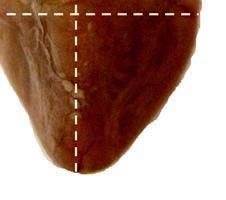
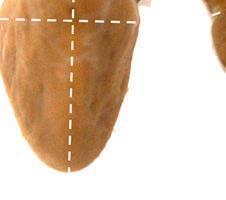

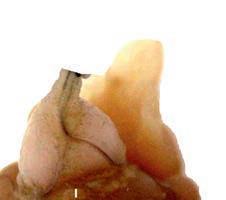

Salmo salar and rainbow trout Oncorhynchus mykiss” in Diseases of Aquatic Organisms, January 2004. Johansen
R”. Illustra�on by Ida Beitnes, NMBU, Norway
in the blood of infected fish. A field-based proteomic study of salmon undergoing challenge with CMS demonstrated that, in addition to four biomarkers traditionally associated with cardiac disease (creatine kinase, lactate dehydrogenase, salmon cardiac peptide and troponins), over 100 other proteins were observed to be elevated in fish that were infected with PMCV, but not clinical for the disease.
Establishing the identity of putative biomarkers for particular disease conditions in fish is currently being investigated for a number of species. It is hoped that either individually or as part of a panel, biomarker profiles can be useful as predictive tools in the early diagnosis of disease as well as other health issues for which the use of artificial intelligence and the mining of large data sets will be crucial.
The development and adoption of new diagnostic techniques will be vital to keep pace with the developments and changes in production methods such as recirculating aquaculture systems (RAS). Techniques such as microfluidic qPCR are being developed to accelerate and expand capability in areas where multiple microorganisms may be present in an attempt to distinguish the problematic from the benign.
As important, particularly in RAS aquaculture, is an improved understanding of how cohabiting fish represent a threat to each other from the perspective of pathogen shedding. The infection dynamics of presmolts infected with PRV-1 has shown that whilst growth of infectees is significantly compromised when compared with control fish, the former do not appear to shed enough virus to threaten the latter during the study period (between 10 and 31 weeks post infection). Thus, whilst this virus can be persistent in the blood and lymphoid organs, shedding may often be at levels too low to establish horizontal transmission.
Viral diseases impacting the heart, for which the most serious in salmon is arguably CMS, was mooted, along with sea lice, as the most important problem facing Norwegian
aquaculture, accentuating the need for diagnostic methods to be improved. These include the detection of PMCV-specific RNA in blood plasma as an early indicator of viraemia, which was suggested as being a more sensitive and robust method of detection than immunohistochemistry whilst still a valuable support to traditional histopathology.
The continuing importance of histopathology as the gold standard differentiator of the three main viral induced myocarditis-related diseases – CMS, pancreas disease (PD) and heart and skeletal muscle inflammation – was stressed. In assessing cardiac health in this way, the development of a universally accepted method of scoring is essential. Currently there isn’t one, leaving a need for such a documented and collaborative process to be developed.
Molecular studies are vital both for the development of vaccines (particular against pathogens that are difficult to culture) and improving our understanding of how pathogens change as they infect and pass through populations. Variations in viral genomes are known to influence the host-pathogen relationship in many mammalian viruses. For PMCV, different rates of infection progression have been observed but not yet explained. Current work is underway to examine how defective, or altered, viral genomes in both PCMV as well as salmonid alphavirus (SAV) 2 and 3 may influence both disease transmission and progression, as well as the development of effective vaccines.
Our ability to rapidly develop nucleic acid vaccines was no better illustrated that in the case of SARS Covid-19. Vaccines for viral diseases of fish are now also the subject of intense research, with both plasmid and mRNA versions under investigation. Vaccine effectiveness not only comes in the form of preventing mortality, but also in reducing viral shedding as well as internal tissue damage within infected fish. Additionally, a comprehensive programme of vaccination has been identified as a key component in keeping the Nord-TrØndelag region of Norway free of SAV 2, which historically had been challenging in this region.
In the early days of TriNation meetings, discussion about vaccines was focused on a single product. Much has changed since then and now both the development of new vaccines, and efficacy of existing ones, enjoys its own programme session. Accordingly, new trial data was presented on the comparative efficacy of a nucleic acid vaccine to PD and novel research into the development of a nucleic acid vaccine to CMS was presented.
Chris Mitchell is Business Development Manager with WellFish Diagnostics.
The (formerly PD) TriNation initiative was established in 2005 to integrate and focus the activities of academia and industry from Norway, Ireland, Scotland and more recently other salmon farming regions. The next meeting will be in Norway in spring 2024. For details on authorship of the material summarised here, readers are encouraged to visit www.trination.org

The development and adoption of new diagnostic techniques will be vital
MAY 23
www.bluefoodinnovation.com
London, United Kingdom

May 23-24, 2023
AQUA
AUGUST 23
www.aquanor.no/en/ Trondheim, Norway
August 22-25, 2023
www.was.org
Darwin, Northern Territories, Australia
May 29-June 1, 2023
SEPTEMBER 23
www.aquaeas.org
The European Aquaculture Society’s annual conference focuses on “Balanced Diversity in Aquaculture Development”.
Vienna, Austria

September 18-21, 2023
JUNE 23
THE SAGB’S 53RD ANNUAL CONFERENCE AND DINNER
www.shellfish.org.uk
June 6 - 7, 2023
SEAWORK
www.seawork.com
Seawork is a “one stop shop” providing access to the commercial marine and workboat business.

Southampton, United Kingdom
June 13-15, 2023
SEAGRICULTURE USA 2023
seagriculture-usa.com
2nd International Seaweed Conference USA.
Portland, Maine, USA (TBC)

September 2023 (TBC)
seagriculture.eu
12th International Seaweed Conference EU organised since 2012.
Trondheim, Norway


June 21-22, 2023
NOVEMBER 23
AFRAQ 2023
www.was.org/meeting/code/AFRAQ23
Lusaka, Zambia
November 13-16, 2023
FEBRUARY 24
www.was.org
San Antonio, Texas, USA
February 18-21, 2024
MAY 24
AQUACULTURE UK 2024
www.aquacultureuk.com
Aviemore will once again be the venue for this biennial trade fair and conference. It is undoubtedly the most important aquaculture exhibition held in the British Isles. The show has a tremendous following and with increased investment for 2024 it promises to reach even further across the broader aquaculture markets in both the UK and Europe.
Aviemore, United Kingdom

May 14-15, 2024
AUGUST 24
AQUA 2024
www.aquaeas.org - www.was.org
Copenhagen, Denmark
August 25-29, 2024
The theme of AQUA 2024 is BLUE FOOD, GREEN SOLUTIONS.
NOVEMBER 24
WORLD AQUACULTURE 2024
Oman
November 2024
MARCH 25
AQUACULTURE 2025
New Orleans, Louisiana USA
March 5-9, 2025




CONSTRUCTION on the expansion for Bakkafrost’s smolt farm at Norðtoftir has been completed and the site has been handed over to the client. The work was carried out by an association of local companies working together under the name of Nordic Aquaculture Contractors.

The companies involved were KJ Hydraulik, Kanjon, RV Tøkni, TTS and Kaas Industribyg. KJ Hydraulik Managing Director Viggo Johannesen says: “To build a smolt farm of this size is a huge challenge. Through building this within a construction association, the Faroese industry has gained a wealth of experience.”
Following the expansion, the smolt facility is now around 18,000m3 in size. Bakkafrost says the joint approach has “worked very well”.
OCEAN Dynamics has ordered a second, deeper-rated Saab Seaeye Falcon for the inspection of instrumentation monitoring of the ocean around Canada’s north-west coast and First Nation coastal waters.

Already an owner of a 300m-rated Seaeye Falcon, Ocean Dynamics’ President, Josh Chernov, says he chose the new 1,000m-rated fibre-optic Falcon because it can accommodate HD cameras and can integrate more advanced technologies. Chernov adds that the Falcon has proved to be reliable, can work for longer than other underwater vehicles and has better-quality video.
AQUACULTURE technology specialist Ace Aquatec has developed a humane stunner for farmed prawns to allow farmers to carry out cruelty-free slaughter. The portable Humane Stunner Universal (A-HSU) for prawns was launched in Boston at the Seafood Expo North America (SENA) trade show. The stunner has been trialled successfully on Pacific white shrimp (Litopenaeusvannamei) with Neomar, Förde Garnelen and Crusta Nova in Germany.

Both UK and European legislation is changing to recognise a wider range of species as sentient and this is likely to mean a need for more humane slaughter methods for species such as prawns, the company says.
THE Centre for Aquaculture Technologies (CAT) has hired genetics specialist Dr Panagiotis (“Panos”) Kokkinias (pictured) as a Breeding Scientist. He holds a PhD in Aquaculture Genetics from the Roslin Institute (University of Edinburgh). He also brings more than 20 years of multi-species, academic and private sector experience in the realm of aquaculture genetics, genomics and breeding. In addition to his doctorate, Dr Kokkinias holds an MSc from the University of Stirling and a BSc from the Technological Educational Institute of Western Greece. Dr Klara Verbyla, CAT’s Vice-President of Genetic Improvement, says: “I am delighted to welcome Panos to the CAT breeding team. His arrival reflects CAT’s rapidly growing global breeding client portfolio.”









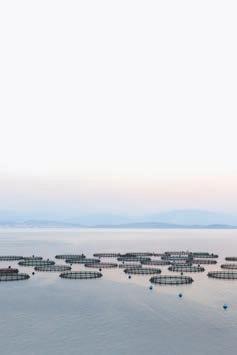

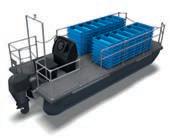
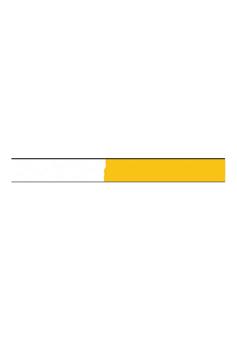








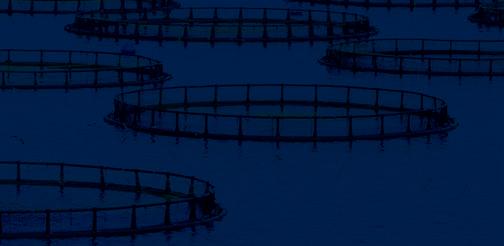

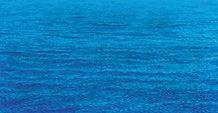






















































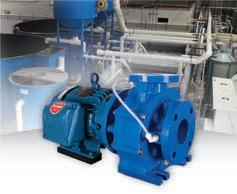






Isn’t it ironic that, finally, when some scientists and government bodies are accepting that the damage to wild fish may not be what the anti-salmon farmers have been saying, that the Canadian government is closing down its salmon farming industry?
I have had plenty of experience in Canada throughout my life. Some of it was very good – for example, when I worked on an Aberdeen Angus farm just outside Montreal when I was very young. I have happy memories of a wonderful time amongst a very friendly people. Unfortunately, my subsequent experience of Canada, particularly the east coast, has been far less pleasurable.
It’s not just that it is one of the most inhospitable places to farm, which it is. Neither is it that, at the time of my association with it, the economy was in sharp decline and salmon farming was not at all popular. It is the Machiavellian way that the Canadian political process operates.
During my time working there, we were told to expect a positive decision on some sites we applied for. On the actual day, the permissions were refused and the government agents told us they were informing the press on the same day. We were given no time to respond and no leeway to appeal. I shall always remember it as the moment when I realised that the system is so loaded against the entrepreneur that I would never invest there again.
At the same time as this, we were doing some work in Mozambique, which was ultimately unsuccessful. Mozambique at that time was the seventh poorest country in the world and also very high on the corruption scale too.
Some years after the Canada debacle, I was invited to meet one of the high-ups from the government in Halifax, Nova Scotia – I warned them that I might be less than charming, but they were quite happy to go ahead. If I had a million pounds to invest, I told them, I would invest it in Mozambique rather than Canada. There were one or two shocked faces. I would love to think that it might have changed things a little, but I have no doubt it didn’t.
Another irony is the huge investment going into RAS salmon production. As I have repeatedly said, it should be regarded as high-energy fish farming just at the time when the world is starting to realise that producing energy is costing the planet. Unless fusion power comes soon, RAS is going down a cul-de-sac.
The only premise supporting RAS is market advantage. I’m sure some of my old colleagues who are passionate advocates will tell you that it is better for fish, but history is heavily against it. The reason everyone is pushing for RAS is because of the negative press surrounding open-water aquaculture.
RAS farming is like feedlot beef. Of course you can do it, but should you? Firstly there is the sheer inflexibility of the system from a production point of view, then there is the interaction between highly complex technology and a large number of living organisms, which nearly always causes suffering.
However let’s put that to one side. Let’s just assume that no RAS farms have failed or killed large numbers of fish. The essential principle that underlies this form of farming is that the market will pay a higher price for it because it is environmentally acceptable. It isn’t, but I’m not going to waste time arguing about that.
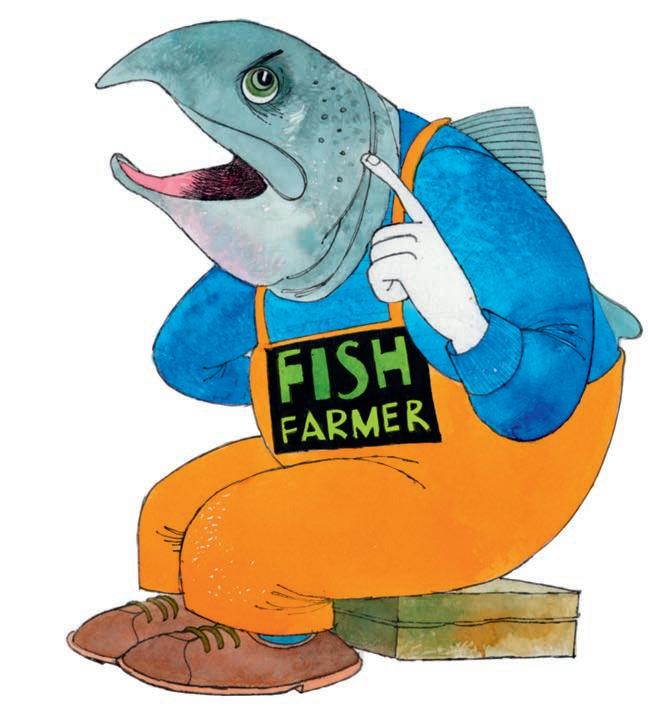
Let’s go even further and assume that a large number of companies are successful. Does anyone really believe that the
anti-fish farming campaigners are just going to go away? Do you think the people who make a healthy living from criticising our industry are just going to accept taking a large number of salmon, stocking them at incredibly high densities in tanks, while burning a large amount of energy to keep them alive?
I remember advising a company that was looking at developing an onshore farm to produce 4,000 tonnes some years ago. The investor was particularly passionate about the project and very clear about the performance which he needed for the project to be financially feasible. The production stats he needed were: average harvest weight 4.5kg, survival 95%, FCR under 1:1, stocking density of 85kg/m3 and a price way beyond anything the market was paying at the time or now. Unsurprisingly, it never got going!
It makes me very sad to look at the impact critics have had, supported by very bad science. Their doctrine has driven some very bad government decisions and very bad investment calls. I hope, as some sanity starts to prevail, its effects will be seen in government and in the investment decisions around our industry.
If I had a million pounds to invest… I would invest it in Mozambique rather than Canada









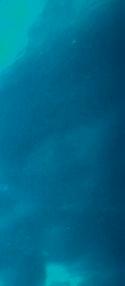

































Clynav™ will turn the way you see PD control upside down.

Clynav is like no other PD vaccine - it uses Elanco’s unique DNA plasmid technology and has become the leading choice for PD protection in Norway. Clynav is delivered intra-muscularly without the need for an adjuvant.









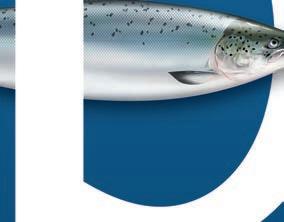









So, with Clynav, you can rest assured of excellent PD protection without the risks associated with conventional vaccines.
Take back control of PD with Clynav. It will change your point of view, for good.





